FASCINATE YOURFRIENDS WITH50FACTS ABOUTOUR BAYAREA


Bay Area NewsGroup $4.95
ABAYAREA NEWSGROUP PREMIUM EDITION
AHA!

Quick sips

These 32fastfactoids — which rangefrom musical to mystical, artsy to athletic, and tragicto technological —will quench yourthirstfor regionalknowledgewith stories that include large lasers, a political poochand apeculiar post officeor two.


PAGE7
AHA!
Bytesacross thebay
Diginto dataabout each of our nine distinctive Bay Areacounties. Check out the flesh-eating flora in Sonoma County,getataste ofhistory in San Francisco, andlearn about ContraCosta County’s connection toJames Bond’s cocktail of choice.
PAGE25
Visual surprises
Feastyour eyesonstunning representations of seven fascinating facts — from ourlocalliterary links to our sinuous streets and thebeloved San Francisco Bayitself — as well as thebestplace to soak in all ofour area’s splendor.
PAGE49
Treat yourself
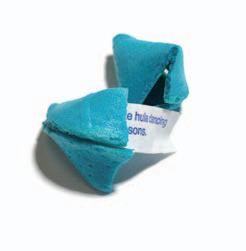
Savorthesetwo long reads about theinteresting and offbeat: Takeatour of severalcurious architecturalcreations across theBay Area,and check outsome perplexing places thatseemto fly in the face of physics.
PAGE65
3 BAYAREANEWSGROUP AHA!
Opposite:Aseagulltakes flight from itsperch onthe MunicipalPier at AquaticPark in San Francisco.
OPPOSITE: PHOTOGRAPHBY JIMGENSHEIMER;ABOVE: PHOTOILLUSTRATIONS BY DOUG DURAN COVERILLUSTRATIONBY ANDREWBANNECKER
Ourpatchwork BayArea
BYTORHAUGAN
Even before I mademy westward relocation threeyears ago, Iknewalittleabout theBayArea. I couldtellyouthat Levi’s andWellsFargo,among the high-water marks of American consumerism andcapitalism, are headquarteredhere.
Butthe first interesting bitof trivia Ilearnedhad to dowith “Star Wars.”
Tomydelight,afriendtold me thatthe cranes thatstand at theOakland shorelineinspired George Lucas to create theAT-AT Walkers, whichfirst appeared in “TheEmpire Strikes Back,”the second filmofthe original trilogy. (If you don’tknow that“Star Wars” reference, youmaybeone of the four people whohaven’t watchedthe original trilogy.Do yourselfafavor, andcheckitout. Youcanthankmelater.)
Thattidbit satisfiedme on such adeeplevel—not only couldI sharethat knowledgewithvisiting familymembers and friends from out of town, but it gave me an odd senseofpride inthe regionIhad just embracedasmynew home.
Itseemedplausible, too. Lucas haslong livedin the BayArea. Lucasfilm andIndustrialLight & Magic, the effectsstudio founded by him,areheadquarteredinSan Francisco.
ButasIamassedmoreknowledge, I learned that the“Star Wars” “fact”was just asfictional as thestoryline ofthespace epic franchise itself.OthertidbitsIpicked up earlyon—including thatMark Twainsaid hiscoldest winter was a summer in San Francisco
Artist VikMuniz createdthe work at right by cuttingup postcards and assembling them into aniconic image. Thispiece, titled “Golden Gate Bridge,”is part of Muniz’s “Postcardsfrom Nowhere”series, which features notablecities andstructures fromaround theworld.

—turned outtobeequallyfalse (Twain never said that), however muchIwanted tobelieveinthem.
Happily, what I have learned about this area sincethenhas more than madeup forthat early disappointment. Turns out the cliche abouttruthbeingstranger than fiction is no fictionat all.
Thisis a placewheresuperlatives suchas “first”and“biggest”are commonlyused — and accurately so. A place where whimsy isbuilt into our homes. Aplacewhere the impossible — such as water flowing uphill —seems tohappenregularly.
Itis,in short,aplace brimming withhidden mysteries and little-known facts.
Thatgutter in thepark? That’s madefrom old headstones.That crackin the roadway? It was commissionedas apiece ofart. Thepicturesquebay you’velooked athundreds oftimes?It’s,on average,onlyabout as deepasa swimming pool.
Thetruthis, there aresomany interesting tidbits about the Bay Area thatweended upculling from morethan triplethe50 major factoids you’llseehere.And they’retrue — every lastone.
Prettysoon (assoon asyouflip thepage —faster than you can say “Sunol dog mayor”) you’llbe kneedeep in fascinatingmaterial about this region. Andthemore youlearn, the more you’llappreciate thiswonderful patchwork of culture, technologyand natural beauty we call home.
Curious?
Keepreading. Wehope youenjoy.
4 AHA! BAYAREA NEWSGROUP
WELCOME
VIK MUNIZ,POSTCARDSFROMNOWHERE,“GOLDENGATEBRIDGE”2015, DIGITALC-PRINT,EDITIONOF6,110X72 INCHES,COURTESYOFRENABRANSTENPROJECTS,SANFRANCISCO ART©VIK MUNIZ/LICENSEDBYVAGA,NEWYORK,NY
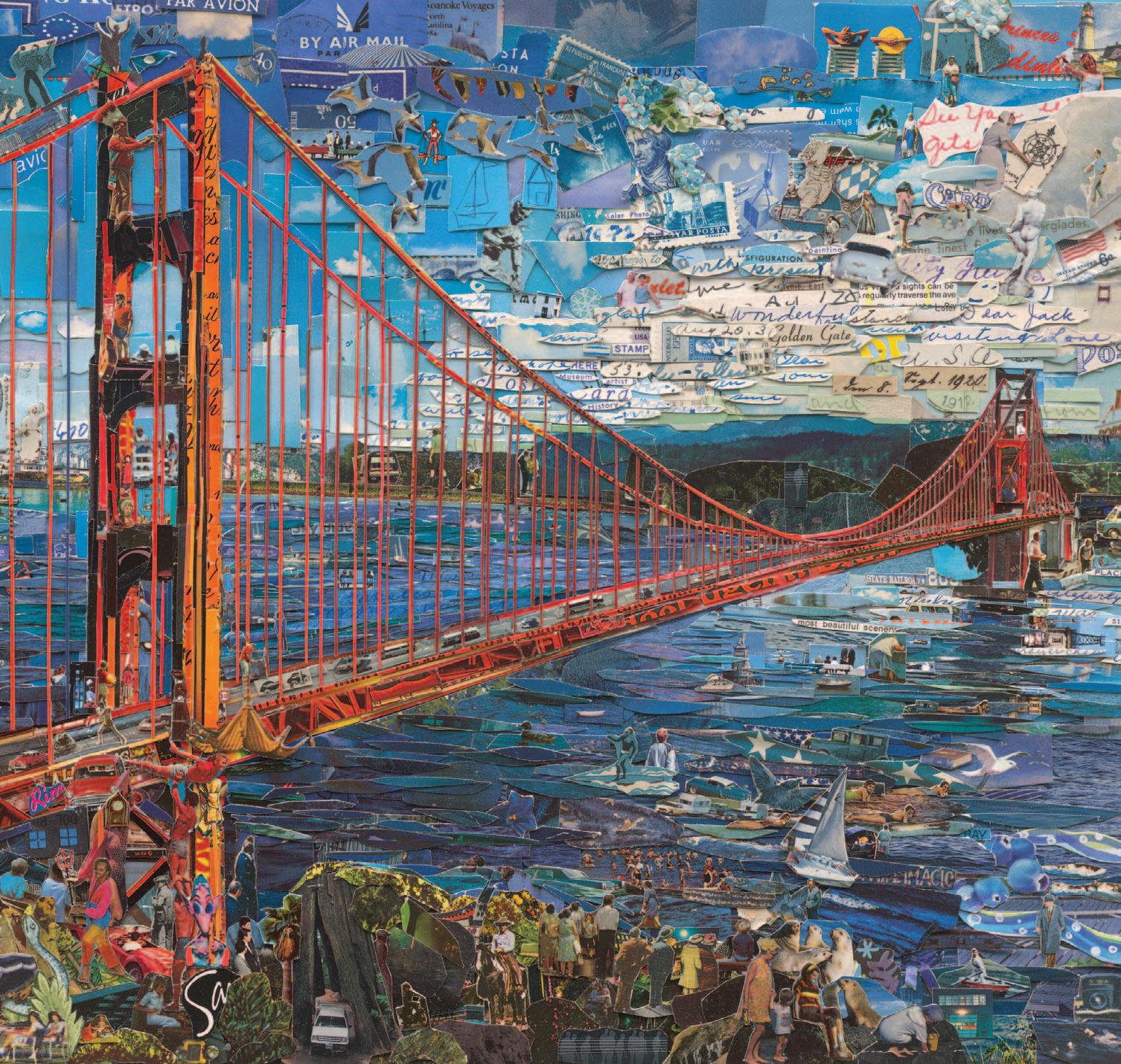
5 BAYAREANEWSGROUP AHA!
There are 12 images hidden in this illustration. Each represents acurious fact aboutthe Bay Area. Can you spot them? Answers, Page82

ILLUSTRATIONBY
BRAINGAMES
STUDIO2&3
QUICKSIPS 32SHORTSTORIES
INVENTEDHERE
JosephB.Friedmanwasathis brother’sestablishment,San inthe193Francisco’sVarsitySweetShop, 0swhenhenoticedhisdaughterstrugglingtodrink hermilkshakewithastraight paperstraw.Friedmanbrought dentalflossandascrthestrawhome,andusing itaccordionlikegroovesthatew,gave allowedittobend.

PHOTOILLUSTRATIONBY DOUGDURAN
Manon fire
Imagine apostapocalypticdesertfullofretro-futuristicdieselpunkcreations andacastofcharactersoutfittedin a kaleidoscopic combinationoffringes, feathers and,sometimes,next tonothing at all. Whatkind ofworld isthis,you ask? (Hint: It’snot the dystopianOutback inGeorgeMiller’s“Mad Max.”) It’sBurningMan, theyearly collectiveoutburstof expressioninNevada’s BlackRockDesert,whichgot itsstart in(whereelse?) the BayArea.On June22,1986, atwhat hasbeen referred toas thefirst BurningMan, LarryHarvey and JerryJamestooktheirwooden effigyofamantoSan Francisco’sBaker Beach andignited it, sparking an annual tradition thatcontinuedinSanFrancisco for the nextfew years.Eventually, however,policeintervened andsaid thenamesakeeffigycould not beburned,giventhe potentialfire hazard. A changeinvenue wasneeded, sothe first Burning Man inBlack Rock Desertkickedoffin1990 — and the rest is flame-filled, mutant car-packed history.(Bonus: Themed temples,which have artisticaswell asspiritual significance for attendees, have become aBurningMantradition, and 2015’sTempleofPromise wasbuilt by the DreamersGuild in Alameda. Final constructiontook placeonlocation.As withtheman,thetemplesare burned eachyear.)

Onetown underdog
Let’s face it: Somepoliticians are all bark and no bite.In 1981, Bosco,ablack Labrador mix, was electedhonorarymayorof Sunol, an unincorporatedtownin Alameda Countywith fewer than 1,000residents. Boscobeattwo (non-canine) candidatesto win theelection. The politicalpooch —whoran as a“Re-pup-lican”— drew hisshare ofmediaattention, evenon theotherside ofthe world. Years afterBosco was elected,aChineseCommunist newspaper, the People’sDaily, apparentlynot realizingthe jocular premise, cited his rise to politicaloffice asanexample of the failureof democratic elections. Bosco serveduntilhis death in1994,butin Sunol, he lives on in spirit. Since 2008, a statue of him stands infront of thetown’spost office.
Thefault inourpark
If steppingonacrackwillbreak your mother’sback, we’dhate to find outwhat stepping on a work of art woulddo.Walking onthis piece, featuredbythe website Atlas Obscura, mightnot be quite thesameas leavingfootprints on the “Mona Lisa.”In fact, Golden Gate Park visitors might not evenrealize that there’san artisticcreation underfoot. If you look down atthe groundoutside thedeYoung Museum inSan Francisco,you can see“Drawn Stone,” which looks like a long, continuous crack. Thework,by Englishartist AndyGoldsworthy, runs from theroad outside the museum throughthecourtyard and to the front door;it was inspired bythe state’stectonic topography.Thecrackfractures off into smaller fissuresand slabs, madeof stone from the artist’s homeland, for visitors to sit on. And some people have the nerve to say modern artis useless.
Lambyou, autocorrect
Do youevergetthesense that technologyisnot cooperating withyou? Well,you’renot alone. One such problem in our digital age is the ubiquitous phenomenon of spell-checkersmiscorrecting aword.Thiserroneous autocorrection hasaname: It’s called the Cupertino effect.After 1997’sMicrosoft Word rolled out, European Union translators began seeingthe name of the South Bay city—the home of Apple headquarters — comeup in their documents.As itturnedout, the unhyphenated “cooperation” had beencorrecting to “Cupertino,” according to a NewYorkTimes article. Thefactoid-packed Mental Flossmagazine notes somegood examples of theCupertino effect in action — including an Italian recipethat instructs cooks to “Stir in prostitute, provolone, pine nuts” andother ingredients. Andwethought prosciutto was expensive.
8 AHA! BAYAREA NEWSGROUP QUICKSIPS
RESEARCHANDWRITINGBYTORHAUGAN ||| ILLUSTRATIONSBY NEARCHOSNTASKAS


QUICKSIPS
Amatteroftime
Here’sastory—recounted intheVallejoTimes-Herald — thatshould stand the testoftime: Apublictimepieceat 316 Georgia St.inthatcitygot thepeculiar name“TheAlibi Clock” becauseofits rolein thecaseoftwo labor radicals accused of setting offabombduring the1916 SanFrancisco Preparedness DayParade.Theparade, in which tens of thousands of people participated,wasorganized to inspire support fortheUnitedStates’entry into World WarIand was a targetofradicals. Inaphotographthatcameup in trial,thetime onthe clock, which originallystoodat MarketStreetin San Francisco, aswell as thelocation, made it clearthat themaninthephoto—Thomas Mooney,who wasseen watching the parade onaroof with hiswife—was nowhere nearthesiteoftheexplosion, which killed 10 andinjured 40.Nevertheless, Mooney,aswell as WarrenBillings — a fellowlaborleaderalso accused inthebombing —wereconvicted ontestimonylater proved tobeperjured, according tothe ACLU,and thetwo were sentenced to be hanged. Thetwo —first Mooney,then later Billings — eventuallywerepardoned. Billings, while serving time in FolsomPrison,learnedskillsto become—getthis — awatchmaker, which hepursued oncehe attained freedom. Tothis day,the mysteryofwho set offthe bomb lives on.
Fan frugality

Can’tafford atickettothe game? Putonyourhiking boots.
Cheapskate fans havehad afree view ofCal football games from Tightwad Hill,overlooking the east rimof MemorialStadium, since thestadium was built in 1923. What towear? Earplugs. Tightwad Hillishome tothe CaliforniaVictory Cannon, whichfiresafter eachBears score. (On one occasion, a1991 game againstPacific in which Cal scored12 touchdowns, the cannonranout of ammo.) What not to wear?Red,the color of rival StanfordCardinal. While you’re up there straddling the Hayward Fault, check outthe Bay Area views,whichcould impress eventhe most jaded Bears fans, who are lamenting the team’s 56-yearRoseBowl drought.
(Bonus:Originally, themascots that appeared atCal’sfootball games werereal,live bears. In 1940, itwas decided togo with acostumedmascot instead, according to Cal. Good call.)
Historylives nextdoor
San Francisco’sFillmore is brimming with cultural significance — onelook atthe massive collection of photos and posterson the walls within the venue willmakethat clear— but passers-bymay notknowthe historical significanceofthe site of theGeary Boulevardpostoffice next door.Thespot once was the location of asynagogue, but the building was vacant by the1970s. Thenit was taken over by a charismaticpreacher(Jim Jones —heard ofhim?), according to “San Francisco’sFillmore District”by Robert F.Oaks. Jones’following grew,he relocatedto Guyana, andthe rest —includingthe infamous batch of grapepunch — is history,as they say.After the1989Loma Prietaearthquake, thebuilding usedbyJoneswastorndown, making wayfor thepost office that stands there today.
Mystical mail
Going to thepost officehasnever beenso adorable. Since December 2013, aknothole in a treeonthe Curran TrailinTildenPark in theBerkeleyhillshas beenhome to a fairy post office, complete withappropriately proportioned furniture. Thinkthe soap dolltree from “ToKill aMockingbird” — but much cuter. The minuscule post office, as recounted by thewebsiteAtlas Obscura, was installedby Leafcutter Designs, acreative studio and online shopbasedin Berkeley.Asofa JunedispatchontheLeafcutter Designswebsite,the postoffice is intactand still in business. Althoughsome itemshave disappeared,hikershave added their own touches, including a tiny stuffed horse, a miniature coat hanger and plenty offan mail. Itmay not have itsown postalcode, but it does have its own hashtag — visitorsareasked to tag their photos with #tildenpo. What makes this betterthan the actual post office?Nolines.
11 BAYAREANEWSGROUP AHA!
RESEARCHANDWRITINGBY TORHAUGAN ||| ILLUSTRATIONSBY NEARCHOSNTASKAS
Let’sgetsmall
Ah,theBay Area—wheretheonly things asubiquitous as yogamatsand plumes ofpot smoke arecomplaints aboutskyhigh housing prices.Ifyou think high costshaveforcedyouinto tinyquarters, consider thefolks whosedigsaremadefrom shipping containers,the metal boxesthat line the bayside landscape.“It’skind ofablankspace,”says LukeIseman,who lives in an EastBay warehouseamongother shipping containersand theirinhabitants.“You can do whatyou want withit.”Iseman leftSanFrancisco andmovedtoaWest Oaklandlot,which became the first BayArea location for his shipping-container dwelling. His issimilar to a studioapartment.Hehasaninduction burnerand convection oven, asinkwith hotwater,a refrigeratorand a shower, andthe warehousehas aflushtoilet.Containers areamere160square feetand cost $2,300, delivered toOakland.Heputabout $10,000 into converting it,including a solar systemand “a lot oflearningmistakes.”
Through his company,Boxouse, Iseman helpspeople wishingto experience the shipping-containerlife.Iseman sayshis way of living hasput thingsinperspective. Inhisoriginallocation,he hadtomove atankofhis ownwaterwithaforklift. “Having to physically move thewater — even with machinery —gavemeasenseoftheamountofwaterweactually use.”
Smooth operator
Moveover, GeorgeWashington Carver.It’stimeto shine alight on JosephL. Rosefield, the father of innovations thathave spread throughout the peanutbutter industry and havestuck around to this day.In theearly 1920s, Rosefield, whosefamily business, Rosefield Packing,was basedin Alameda, filedapatentfor the partialhydrogenation process to make modern, nonseparating peanutbutter, accordingto “Creamy and Crunchy,”ahistory of peanut butter. And hisprocess of churning, ratherthangrinding, peanutsgavehis peanutbutter asmoother texture. Healso began using wide-mouthjars, now the industry standard.As if that weren’tenough, he invented chunkypeanutbutter. Rosefield Packing was aheadofits time —it wasmakingachocolate-andpeanut-butter confectionas early as 1918, yearsbefore theReese’scup came out. A monument atWebster StreetandAtlanticAvenue marks theformer location of Rosefield Packing, which alsooriginated Skippy,still populartoday.

No‘H’? Noproblem
What’sin aname?In thecase of the East ContraCosta city of Pittsburg, quite a lot, it turns out. Pittsburg, thetownof60,000-plus residents at theconfluence of theSacramento andSan Joaquin rivers, hasahistory of changing itsname. The town was called NewYorkof thePacific,possibly because theman who laidout thetown wasaNewYorknative, and was renamedBlack Diamond after coal was discoverednearby. Avote in 1911 establishedthe moniker usedtoday.According to the city,Pittsburg was named after Pittsburgh, Pennsylvania, aplacewith which itshares a historyof steelmanufacturing — Columbia GenevaSteelopened in Pittsburg in 1906.The “H”was removedtosimplify the spelling.
FreedomMarch, BayArea-style
Before theBlack Power salute seenaround the world, San JoseState Spartan (and 1968 200-meterOlympic gold medalist) TommieSmith was involved inactivismin the Bay Area.According to his autobiography,he joinedother SJSUstudents and athletesin a60-milemarch,which took place March 13-14,1965,from the campus to San Francisco. Like any world-class athlete would do, Smith setoffto join the other marchers—who weresupporting the efforts of thepeople fighting for civil rights in the South—only after participating in a track meet. Althoughtheendofthe march was somewhatanticlimactic — the politicianwhowassupposed to meetthem didn’tshow up — it was important for Smith. Inhis words, “It signifiedfor me,forthe first time, that beingoneofthe best in the world in anyactivity obligatedyoutocontribute.”
12 AHA! BAYAREA NEWSGROUP QUICKSIPS
RESEARCHANDWRITINGBYTORHAUGAN ||| ILLUSTRATIONSBYNEARCHOSNTASKAS


Makingwaves
Intheworld ofsportsand beyond, “TheWave” hasmadeasplash.Whathas beencalledthefirst recordedWave occurredOct. 15,1981, in Oakland atan A’splayoffgame againsttheNewYorkYankees, and was led by cheerleader Krazy George Henderson, aSanJose State alum.As theSanFrancisco Examiner’sBuckyWalter later wrote:“A study of the NBCvideotapeverifies Krazy George’sclaim. Inthefifth,seventh and ninth innings,arollingwave occurred. It wasunmistakably,indisputably the inception of theFan Wave.” Henderson has led cheers formore acronymic sports organizations — including theNBA,MLBandNHL — thanyou can shake a drumstickat(he’sknown forleading cheerswithhistrustyhand drum). These days, theWavehappensateventsaround theworld. One place where theWave hasn’tcaught on? AT&TPark. Although the Waveisnot banned there, many Giants fansfrownupon it. Recently,as a contestant in the 10th seasonof“America’sGot Talent,”Hendersonledthe audience inaWavebut wasquickly buzzed by the judges,whogave himawave of their own—wavinghim goodbye.Butit’sclear Henderson has madeanimprint, and he’sstill going strong. As Hendersonhimself says inthe titleofhis ownbook, he’s“stillkrazyafter all these cheers.”
UnitedNations— inMoragaValley?
TheBay Area isavirtual United Nations ofsorts —ahotbedof diversity.Butthe regionhas an early linktothe historyof the actual United Nations.In 1945, ameeting of nations was held attheSan Francisco Memorial Opera House, atwhichacharter was producedthat wenton to establishthe U.N.Interest in Contra Costa Countyasa location for U.N.headquarters was reportedas early asMarch 1945.The ContraCosta Board of Supervisorsendorsedthe notion of placingU.N.HQin Moraga Valley,and thearea was toutedfor itslandandtheease of access from San Francisco, according to “Capital of the World” byCharleneMires.Site inspectors, however, rejected the idea infavorofasite closer to San Francisco. Since1952, acomplex in Manhattan has servedasthe U.N.headquarters.
Pixar touch
Weall know that Emeryville is home toPixar.But casual viewers of thestudio’sflicks may not know howmanyBay Area touches make it intothe movies. Emeryvillegets somelovein films suchas “Cars” and“ToyStory 3” (an application for acollege locatedin Emeryville isseen on Andy’sbulletin board). For 2007’s “Ratatouille,” producer Brad Lewis internedat Yountville’s famedFrench Laundry.Local favorite FentonsCreameryin Oakland is in 2009’s“Up.”“Inside Out,”releasedthis past summer, is set inSan Francisco and features numerous Fog Citylandmarks. And Richmond’sHidden CityCafe (now closed) is seenin“Monsters, Inc.”Thecafe is said to be the site wherePixar filmmakersspawned theideasfor“A Bug’sLife,” “Monsters, Inc.,” “FindingNemo” and “WALL-E” —inonemeeting. Notbad foraday’swork.
The(firstand) lastemperor
San Francisco is fullof highsocietytypesnowadays.Butdid youknow it also was hometoan emperor? In1859, JoshuaNorton, an English-born businessman who losthis fortune, pronounced himself the “Emperorofthe UnitedStates and Protectorof Mexico” inthe SanFrancisco Bulletin, according to theSan Francisco Museumand Historical Society.San Francisco residents embraced theself-proclaimed emperor,and theeccentricNorton —who,amongother“official” functions, issuedproclamations, had his owncurrency printed and attended sessions ofgovernment —becamesomething ofalocal celebrity.Herode freeonpublic transit and was immortalized by one of the American literary greats: MarkTwain, who moved to San Francisco while Norton was emperor,revealedthat thecharacter of the King in “Adventuresof HuckleberryFinn” was based on Norton.

15 BAYAREANEWSGROUP AHA! QUICKSIPS
RESEARCHANDWRITINGBY TORHAUGAN ||| ILLUSTRATIONSBY NEARCHOSNTASKAS
Restingamongthebest
Millamongmillionaires andother interestingfigures at Oakland’sMountain View Cemetery.Along with itsstunning views, thecemetery is known as thefinal restingplace ofbusinesstycoons, politicians, Civil Warveteransand eventhe victim of anotorious, unsolvedmurder.Among thoselaid torestat thecemetery,located at the endofPiedmont Avenue, are architect Julia Morgan, who designedhundreds ofbuildings, including Hearst Castle;BernardMaybeck, who mentored Morgan anddesignedSanFrancisco’sPalaceofFineArts; physicianand formerOakland MayorSamuelMerritt(and MerrittCollegeand LakeMerrittnamesake);Ina Coolbrith, the state’sfirst poetlaureate; multiple Californiagovernors; and Elizabeth Short, “TheBlack Dahlia,” whose 1947murder in Los Angelesremainsamystery.JamesA.Folger,of coffee companyfame,DomingoGhirardelli — yes,thatGhirardelli — and mining magnate Francis Marion “Borax”Smithalso rest atthehistoriccemetery,designedbyfamedlandscapearchitectFrederick LawOlmsted,whoseprolificcareerincluded designing NewYork’sCentral Park and theStanfordUniversitycampus. (Bonus: They may notbeconsidered Wonders of the World, butthe cemetery’spyramid-shaped mausoleums are sightstobehold —providedyou can spotthem.)
Cafe ofcats
Who knewthatcats andcaffeine pairsonicely? Toexperience this curious combination, look no furtherthan Oakland’sCat TownCafe, at2869Broadway, whichbecame the nation’sfirst permanentcatcafewhenit opened inOctober 2014.Cat cafes offer patrons the chance to grab a biteandinteract with feline friends inasingle venue, but to satisfyhealth regulations, Cat Town Cafeissplit into two: Ithasacafe, which offers coffee and baked goods,andthe Cat Zone, with free-roaming felines awaiting adoption.TheCat Town Cafe, which helps emptycages at theshelter,is an extensionofthe effortsofCatTown, anonprofit cat rescue organization. But the concept ofcatcafes is nothing new —they arepopularin Japan, and sinceCat Town Cafeopened, other catcafes have appeared in various locationsacross the country.To make adonation or aCatZone reservation, goto http://cattowncafe.com.

Gay,not-so-gay bythebay
Yes,San Francisco is something of a Promised Landforgay folks. It has theCastro, the Pride Parade, andmore gaybars and rainbow flags than you can shake astickat. Itmay come as no surprise, then, thatthe resultsof aGallup surveyreleased inMarch of the 50 biggestmetropolitan areas in thenationshowedthe San Francisco area (including Oakland and Hayward)has thehighest concentration of LGBT-identified residents inthe nation, at6.2 percent.Nothing shocking there. Infact, it’dbe kindof shocking if thatweren’t true. On theother hand, the San Jose area (including Santa Claraand Sunnyvale)ranked as havingamong thelowest concentrations, at 3.2percent. Note: Ifyou’rekeepingtrack,it was the Birmingham, Alabama, area thatcame in as havingthe lowest rate—2.6 percent—of LGBT-identified residents.
History laidbear
Seenabear in California lately? If you’vebeentoazoo, Folsom StreetFair or Bear Pridelately— whoops, wrong kindofbear — the odds are quite high.But we’re talking wild grizzlies, which have beenwipedout inCalifornia. So howdidthe grizzlygeton the stateflag? Despite whata gag Snopes.com entrysays, the bear was not included onthe flag because someone misread the word “pear”—“PearFlag Republic”just doesn’tsound right, anyway.To learn the real answer,wehavetogoback to the Bear Flag Revolt.In 1846, agroupof Americans captured the cityof Sonoma from the Mexicangovernment. California was declared independent, and aflag was raised.The banner included a star andabear,an animal that wasfairlycommon back then. Thatflag servedas the basis of theCalifornia flag we seeallover the state today.
16 AHA! BAYAREA NEWSGROUP
QUICKSIPS
RESEARCHANDWRITINGBYTORHAUGAN ||| ILLUSTRATIONSBY NEARCHOSNTASKAS


QUICKSIPS
Abiggerbeam
Itmight not be attached tothehead ofashark, but wethink it’sstill prettydarn cool.Lawrence LivermoreLab’s NationalIgnition Facilityishome to the largestand highest-energylaser systemintheworld,according tothe U.S. Departmentof Energy.NIF’s192 beams, housed ina10-storybuilding,canemitnearly2millionjoulesofultraviolet laser energy inbillionth-of-a-secondpulses onto a targetabout the sizeof apencil’seraser.Last year,the laser system made news because of a newstudy inwhich scientistssubjecteddiamonds tothelasersystemto getasense ofwhat happens in thecores of huge planets.(Using diamonds inthe name of research? What’snext? Achinchillacoat and Cristal?)Those planetarycores,much likefranticrush-hour commutes across thebay,canbehigh-pressure situations — which is whythelasercame inhandy. Ifyou’re aTrekkie — if you’ve readthis muchaboutlasers,the oddsare not low—then you might already knowthatNIF was seeninJ.J.Abrams’“Star TrekInto Darkness,”where it playedtheEnterprise’swarp core. We’rehopingthe facilityand the lab’shelpful innovations live long and prosper. Side note: There arenoknown plansfor Abrams to use the NIFinanyupcomingmovies. Butafanboy can dream.
Fatal attraction
TheGreat Wall of China, the Eiffel Towerand theGolden Gate Bridge: Aside from being tourism hotspots, alloftheseplaces are also knownas “suicide magnets.” In1995, as the numberof Golden Gate Bridge jumpers approached 1,000,aradio DJ offered afree case ofSnapplefor thefamilyof the1,000th jumper.InJuneof that year, todiscouragerecord breakers, theCalifornia Highway Patrol stoppedthe officialsuicide countat 997,according to news reports. Theunofficial1,000th jumper —a25-year-old man — leapt from thebridge the next month. Last year, the Golden Gate Bridge board approved funding and a design for asuicidebarrier on the bridge,meantto deter would-bejumpersfrommaking theplunge of morethan200 feet.
Ifwalls couldtalk...
Theformersite ofwhatwas referredto as the “GreatAsylum for the Insane” now is occupied by one of Silicon Valley’shottest tech companies.Agnews inSanta Clara,which was established in the late 1800sas afacility for the mentallyill,probably is best-known asthe place where more than 100 peoplewerekilled in 1906afterthe San Francisco earthquake;it’ssaidtobethe greatestloss of life in Santa Clara County.Since1997, Agnews has beenon theNational Register of HistoricPlaces. So who nowowns thehistoricspot thathas drawn interestfrom everyonefrom historybuffs to self-styledghost hunters? Oracle,which usesitfor R&Dandasaconferencecenter. (Bonus:GreenDay,thehugely successful pop-punk outfit from theEastBay,filmed the music video for“BasketCase,” a single from theirlandmark “Dookie” album, atthelocation.)
Wherethe buffaloroam
“Whatazoo!” isan expression usuallyreservedforplaces such as Pier 39and similartourist traps within San Francisco. Butdid you know thatGolden Gate Park once was the site of an actual free-range zoo?It included goats, elk, caribou, zebras,peacocks, quails, kangaroos, bison andevena bear pit. In thelate 1920s,Park Superintendent John McLaren suggested that thecity find a better localefor azoo,and the animals becameapart of the San Francisco Zoological Gardens.Today,near Spreckels Lakein thepark, furryreminders of the park’szoological past roam thelandscape. Thebisonarethe last remaining vestigesofthe park’smenagerie of animals. Theywere moved from the easternpartof thepark to the meadow theycurrentlyinhabit, and they’recared for by San Francisco Zoostaffmembers.

19 BAYAREANEWSGROUP AHA!
RESEARCHANDWRITINGBY TORHAUGAN ||| ILLUSTRATIONSBY NEARCHOSNTASKAS
Simplygroundbreaking
TheSanJose Earthquakeshave shaken thingsupwith theirnewstadium. Before AvayaStadium even existed, thestructure’s groundbreaking wasrecognized by GuinnessWorld Recordsas theworld’slargestintermsofparticipants. There were 6,256 people on hand for theOctober 2012event, andtheEarthquakesprovided6,000shovels for fanstobreakground. Tomake itofficial, everyone had to pitchinfortwominutes. Since the participantsoutnumberedthe shovelsprovided, some people usedtheirown shovels, andsome were more creative.“Somekids brought a Tonka truck withalittle scooperon it,” says Jed Mettee, vice presidentofmarketing and communications.Apart fromthegroundbreaking,the stadium holds some distinctions of its own. Itis thefirstcloud-enabled stadium inMajorLeague Soccer,and its robustnetwork makesiteasier to add newtechnologiesin the future.If you’reatechie, you mighthavenoticed thatapattern of coloredseats in sections117 and 118spell out a secretmessage—“GO EQ” — inbinary code. Andwhatbetterplacefor a seismographthanEarthquakes HQ? The U.S. GeologicalSurveyhas installed onein the Earthquakesofficestodetectground movement, andit’ssensitive enough to recordvibrationsof roaring fans. (Bonus: TheEarthquakeswereSan Jose’sfirstmajor professional sports team.)
There’s alight
TheLivermore area has seenalot of lightbulb moments —some in itslabs, someatits vineyards.But what happenswhen alightbulb moment lasts for more than a century? That’sexactly what’s happening atFireStation No. 6, home ofthe Livermore Centennial Light Bulb, whichhasbeen burning, albeitnotcontinuously, since it wasinstalled in 1901. Thebulbhasbeenburning 24hoursadaytoilluminate thefire engines, but it has been moved afew times, mostrecently in 1976 to its current location. The hand-blown bulb with acarbon filamentoriginally glowedat60 watts but now burnsat 4 watts, and it has beenrecognizedby Guinness World Records as thelongest-burning lightbulb. Sound familiar? You might have seenit on “Mythbusters.”

Straightfrom the‘Heart’
TonyBennett,who has been introduced toawholenew audiencethrough hisduets withLadyGaga, isatime-tested crooner of the highest caliber. And we’veallheard “I Left MyHeartin SanFrancisco,” his signature song,yetmany people maybeunfamiliar with itsoriginstory.Thesongwas written inthe early 1950sby agaycouple,lyricistDouglass Cross andcomposer George Cory,who lived inthe Bay Area but relocatedto NewYork.Cross grew upin Oakland and Coryin San Francisco and MillValley, according to reports, andthe twocame back to Californiain the’60s — in time forthemto seetheirfamous work be named San Francisco’sofficial song. On Valentine’sDay 2012, San Francisco celebratedthe50th anniversaryofBennett’s signature song, and Mayor Ed Lee declared the occasion “TonyBennettDay.”
Thestoryabout morningglory
What adrain!TheMorning Glory Spillwaynear Napa County’s Monticello Dam, whichdams LakeBerryessa,generally is knownasthe largestdrain hole —atype ofspillwayshaped likea giganticcement funnel — in the world, according to aU.S. Bureau of Reclamation official. Cheekily referred to by locals as the “TheGloryHole,” itis 72 feet across and allows watertobypass the dam when the lakereaches its capacityof1,602,000acre-feet. Thehole, which is writtenabout atthe website Atlas Obscura, was constructedin the 1950s andcan beseen by lake visitors andonGoogle Maps. Some skateboarders and BMX bikers have beenknownto usetheexit pipe—afull pipe—as a spot to shred. But if you think “TheGlory Hole”beckons you, thinkagain.In 1997, aDaviswomandiedwhen she was suckeddown the spillway.
20 AHA! BAYAREA NEWSGROUP QUICKSIPS
RESEARCHANDWRITINGBYTORHAUGAN ||| ILLUSTRATIONSBY NEARCHOSNTASKAS


QUICKSIPS
FabFour’s‘Hello,Goodbye’
Here’ssome Beatles trivia thatyou can’tgetby playingoneoftheir records backward.Althoughthe Beatles—and Beatlemania — spanned the globe, the venuetheyplayed ontheir firstNorth American tour date and the location where they performed their finalscheduledconcertwerewithin miles ofeach other. Althoughthey had performedshowsintheU.S., theFabFour kicked offtheir firstproper North American tour Aug. 19,1964,at DalyCity’s Cow Palace.And it was adjacent San Francisco thatserved asthebackdropfortheendofachapter fortheBeatles. Their finalannouncedconcert tookplace Aug.29,1966, atCandlestick Park,although thefamous, unplanned rooftopconcert inLondon occurred inJanuary 1969, marking the band’sfinal publicperformance.In afull-circlemoment,inAugust2014,SirPaul McCartneyreturned to Candlestick forapredemolition show atthestadium. (Bonus: Howdidthe Cow Palacegetitsname? Thelivestock portion of the 1915Pan-PacificInternational Expositionprovedpopular,prompting businessleaders to comeupwith anidea for apermanentvenue for an animalexpo.Duringthe GreatDepression,the ideaofusing public money for the site duringa period ofsuch great struggle caughtflak,leadingone newspaper writer to questionthe ideaof funding a “palace forcows.”)
Wind itup
Where isthe largestwind tunnel in the world, you ask? The answer, myfriend, is blowin’ inthe wind. Actually,the answer is Mountain View’sNASAAmes Research Center.TheNational Full-Scale AerodynamicsComplex, orNFAC, locatedat Ames, is hometoa 40-by-80-foot testsection and an 80-by-120-foot testsection, thelatter of which is capable of testing a full-sizeBoeing 737.These two testsections are thesecond-largestandlargest windtunnels in theworld, and according to NASA,nearlyevery model of major commercial American aircraft builtin thepast quarter-centuryorsohasbeen testedat NFAC.The larger of the twotest sectionscan providetest velocitiesofasmuch as100knots, or 115 mph, and the smaller can blow you away atspeeds of as muchas 300knots, or 345 mph.
Adifferentkind of#PizzaRat
Longbefore#PizzaRatwas dragging NewYorkslicesacross subway floors (YouTube itif you don’tunderstand), another pizza ratwas looming largeinSan Jose. The statue, saidto bethe largestratin theworld,resides ataChuckE. Cheese’soutpost near Highway101 andTully Road in SanJose. Who came up with theidea forthe larger-than-life rodent? Nolan Bushnell, thecofounder of Atari and founderof Chuck E. Cheese’s.The building had avery large window,and Bushnell“felt the best use would be to fill it with the rat.” Bushnellalsois the reason for a ratbeing thepostercritterforthe establishment in the firstplace —but itwas throughahappy accident, when he bought what he thought was acoyotecostume atatradeshow. (Bonus:The first Chuck E. Cheese’swas atTown and CountryShoppingCenter on Winchester BoulevardinSanJose and was an immediate success.)
Noplace likegnome
Afew years ago,in the neighborhoods near Lake Merritt, little fellowswith pointyhats and beardsbegan poppingup in largenumbers. No,we’re not talking about hipsters (though thereareplenty of those, too). We’re talking about gnomes.The inches-tall paintedfiguresare seenon pieces of wood affixedto telephone poles,at sidewalk level. Theyhave pleased manypassersby, whose days aremade alittle more magical by their presence. ButPacificGas&Electric at first saidthemystical creatures were compromising its equipment, and theutility wantedthem removed. PG&E, however,later reversed courseafteranoutpouring of support forthe little guys, and declared the utilitypoles“gnomeman’sland.”(Bonus:The gnomes tendto live near Lake Merritt, whichholds adistinction of its own. Designated in 1870,Lake Merrittis the oldestofficial wildliferefugein the nation.)

23 BAYAREANEWSGROUP AHA!
RESEARCHANDWRITINGBY TORHAUGAN ||| ILLUSTRATIONSBY NEARCHOSNTASKAS
BRAINGAMES
ForthisBayArea-themed puzzle,enterthesolutionstotheclues below. Then unscramble thehighlightedletterstosolveforthefollowing: Scenes fromthisOscarwinnerwereshotatSan Francisco’sPier45.
1Theworld’slargesttemporary corn maze,verifiedbyGuinnessWorld Records, wasmadein thisnortheastern BayArealocation.
2Thistoweris thethird-tallest bell and clocktower in the world.
3Thisfamedfamilial duo offunnymen attendedSanJoseState.
4Adistilleryinthis city wasthe firstinthenationto releaseAmerican-madeabsinthe after thebanwas liftedin2007.
5Thiscastlelikestructure in Richmond, now abandoned,oncewasknown as theworld’slargestwinery.
6Seabiscuittrained for hiscomeback atafacilityinthis city.
7Thisiconic writerranfor Oakland mayorontheSocialist ticket.
24 AHA! BAYAREA NEWSGROUP
FINDTHEANSWERON PAGE82 1
6 7
2 3 4 5
BYTES ACROSS THEBAY
ATALEFOR EACH OFOURNINECOUNTIES
INVENTEDHERE
In the late 1960s, aSanJosebasedteam of IBM engineers, working under David L.Noble, came up with a flexibleMylar disk coatedwithmagnetic material that could bespun. The first floppies were8inches anduncovered, andthus open to contaminants. The team then put themin sturdyenvelopes, protecting them fromdust, therebygiving us an important piece oftechnologythat,along with typewritersand eighttracks (and, eventually, one hopes, e-cigarettes andselfie sticks) can be counted amongthe victims of the lightning-fast pace of technological innovation.
 PHOTOILLUSTRATIONBY DOUGDURAN
PHOTOILLUSTRATIONBY DOUGDURAN
From a railing justabove Boudin Bakery’sbustling workplace, Fernando Padilla signals for one of his fellow bakers to toss him achunkofdough.
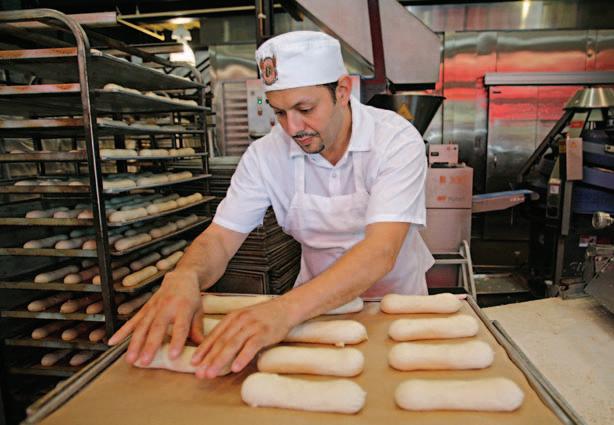
Thesoftball-sizedglobsettles softly into Padilla’shands, and he pulls it apart and holdsit to his nose for a deep inhale.“Ilove that smell,” hesays.
Thisis thespecial stuff, the historicstuff. It’sapiece of the so-called mother dough, thewild yeast starterthathas gone into everyof loaf of sourdough bread bakedbyBoudinsince 1849.Padilla is Boudin’smaster baker,andit’s his jobtomakesure themother dough endures.

“This islike Coit Tower, the cable cars, the GoldenGateBridge,” Padillasays,rolling thedough in his hand.“Boudinsourdough right here at the Fisherman’sWharf is iconic. It’sSan Franciscohistory.If we run out of it, weshut thedoors.”
ToBoudin,thisdough is the greatestinventionsince before slicedbread (whichcame along in 1928).The bakery wasborn in 1849,whenanimmigrantnamed Isidore Boudin,whohailed from a familyof master bakers inBurgundy, France, kneaded a hardydough and formeditintotheshape ofa traditional French loaf.
Evenafter theintroduction of commercialyeast in1868, Boudin Bakerycontinued tomake bread thewaybakershad done for centuries. They setasideaportion of the previousday’sdough toprovidethe naturalyeastfor leavening thenext batch.To this day,there’satraceof theGold Rusherain eachbite.

Boudin’smother dough even survived the greatearthquake of 1906.When the quakestruck at 5:12 a.m.thatApril 18, settingoff firesacross San Francisco, Louise Boudin tossedsomemotherdough into awooden bucketandfled thescene justbeforethebakery

Atasteofhistoryineverybite
burnedto the ground.
Padillaunderstands that,incase of emergency,he’dbe called upon to do the same. Heapprenticed under former Boudin owner “Papa Steve”Giraudo. And late inGiraudo’slife, he handed the reins to Padilla. “Hesat me downandtold me all thethingshe wanted me to take care of,especiallythe mother dough,”says Padilla, who isin his 36th year atthe bakery.“He said to me, ‘Don’tworryaboutthe ups anddowns ofthe business. But if you takecare ofthe breadand the mother dough, they willtake care of you.’And it’strue.”
Padillanowpassesdownsuch lessons tohis underlings. Heteaches classes for Boudinemployees — they callit Sourdough University.

Bakers also learn the science behind why San Francisco sourdough tastes different (andbetter) than anywhereelse onearth. The quick version: SanFrancisco’s foggyweather creates anideal environmentfor thewild yeast and thelactobacilliin sourdough. The ingredients thrive in what Padilla called“a symbiotic colony,”and things work especially well close to San FranciscoBay.The taste simply can’tbereplicatedinother parts of thecountry.
Padillanow oversees theoperation thathas locations all over California.Betweenthethird and fourth weekofeach month, Padilla will ship acontainer of 30 or 40 pounds of mother dough from the flagship. Whenit arrives, theotherbakeries areinstructedto bake theold dough (thusdestroying it) and “start a wholenewbatch so that theyhave a strong injection of the San Francisco starter,”Padillasays.Inall, the Fisherman’sWharflocation pumpsout 20,000pounds ofdough a day.
“Beingable to keepthis alive andhealthy,it’samazing,”Padilla says.“It’shistory.It’spart ofSan Francisco.”
Clockwise fromtop left: A bas-reliefshows Isidore Boudin, the founder of Boudin Bakery; a locked box contains Boudin’smother dough;Victor Gutierrez shapes sourdough rolls; rounds arescored before they are baked. Atright: Master baker Fernando Padilla can talklike a professor, with his references to bacteria, fermentation, andpHlevels. Butwhen he talks about the mother dough, he sounds more oftenlikea doting uncle: “Youneed to keep the mother healthy so shecan keep having babies andbabies andbabies.”
26 AHA! BAYAREA NEWSGROUP
BYTESACROSSTHEBAY
SANFRANCISCOCOUNTY ||| STORYBY DANIELBROWN ||| PHOTOGRAPHSBY JIMGENSHEIMER


The old militarybunker,once buried in anestof rock, now restsatopacoastal blufflike apartiallyexcavatedfossil. With itsmetal-and-concrete shell exposed tothe oceanairand covered by graffiti, theWorldWar II observationpostoffHighway1 is SanMateo County’smostevocative reminderofalargelyforgotten era—atimemorethan70 years agowhen theU.S.military and BayArea civilians prepared feverishly foranenemy assault that never came.
Thebunker, the centerpiece ofLittle DevilsSlide Military Reservation, was one of five “fire controlstations” built by the Army atDevilsSlide, betweenPacifica andHalf Moon Bay.Men in thesestations keptalookout for attacking Japaneseships.Their job was to telephonetheenemy’s coordinates to massivegun batteries inthe Marin Headlands and at FortFunston.
Justafew miles down the coast,the Army also built an outpost with a radar tower and anti-aircraft machine gunsalong Pillar Point Bluff(now the Pillar PointAir ForceStation)anda mile-long airstrip(now HalfMoon Bay Airport).
These measureswerepartof asprawlingdefensivesystem the Army began constructing inthe 1930s around themouthofthe GoldenGate.The worktook on new urgency in 1941afterthe JapanesebombedPearlHarbor.
Thebuildup reflectedthe strategic importanceof San Francisco Bay,notonly a vital transportation hub, but also home toMare Island and Hunters Point naval shipyards, among other military installations. TheArmysuspended hundredsofmines inthe ocean outsidethe bayand strung asubmarine net across the inside.
“San Francisco’sharbordefens-
BYTESACROSSTHEBAY
es were the No.1priorityfor the Corps of Engineers on thePacific Coast,”said StephenHaller,a historian with theGoldenGate NationalRecreation Area. The agencynow owns mostofthe old coastalfortifications.
Amidthisvastmobilization, San MateoCounty’sslightlymore than 110,000residents threw themselvesinto civilian defense initiatives andsalvage drives. The archives of the countyhistory museum preservemuch oftheir efforton thePeninsula.
TheThree CitiesDefense Council,representing San Mateo, Hillsborough and Burlingame, reported in August1942 that its salvagecampaignhad gathered75 tons of scrap metal and 500,000 pounds ofrubber,along with various amounts ofkeys, rags and grease.
All this effortmaynot have matteredmuch in the outcome of the war,but it proved essential for public morale, said Mitch Postel, president of the San Mateo CountyHistoricalAssociation.Andthe Bay Area’sseacoastdefensenetwork, thoughnevertested by the Japanese,served asaneffective deterrent.
Thefire control stations atDevils Slide have faded into semi-obscurity.Public accessisrestricted becauseofthe precariousterrain.
TheLittle Devils Slide bunker acquiredits peculiar appearance afteraMontara man bought the land from the militaryand dug awaymuchofthe bluff, only to abandon his plantodevelop the property.Fewpeople know the odd-looking building is animportant partof theregion’smilitary history.
“It’sakind of a lonely, ghostly structure,”Postel said. “Ithinkpeople passby and say,‘Gee,Iwonder what theheck that is,’andthen nevergiveitanother thought.”
San Mateo County’sLittle Devils Slide Bunker,a triangulation andobservation station from the World War II era, isperched precariously atopDevilsPeak, appearing as if it willslideoff at any moment. Graffiti covers many interior spaces within the structure.

29 BAYAREANEWSGROUP AHA!
‘Ghostly’reminderofWorldWarII
SANMATEOCOUNTY ||| STORYBYAARONKINNEY ||| PHOTOGRAPHSBYPATRICKTEHAN
Some celebrities areknown to becompleteasses.None of them, however, wears the label as well as Perry,aminiature donkeywho residesinPalo Alto’s Barron Park neighborhood.

Perry’sclaim to fame? He servedasthe model for thehappy-go-lucky Donkey—voiced by EddieMurphy — whostole scenes and hearts inthe wildly popular computer-animated “Shrek” films.

“Youcan look atthosemovies and reallytellthatit’shim,” says DonAnderson, oneof thetwo dozenorso volunteerswho tend to the animal. “Theyshortened his legsabit andmixedtracesof EddieMurphy’sfaceinwith his, but he’sstillPerry.”
Born in1994 and as photogenic as ever,Perry—shortfor Pericles—liveswithfellow donkey MinerForty-Niner(known as Niner) behindBol Park. Theyare themostrecent inalong line of donkeyswho havehung outhere since theearly 1930s,whentheir turf was part ofapasture owned by thelate Stanford physicistand gentleman farmer CornelisBol.

Thetraditioncontinues,thanks to the generosityofcurrent landowner James Wittand the volunteers who oversee the feedingandwelfare of the donkeys. EverySunday,Perryand Niner are trottedout to meetvisitors young and old. On occasion, theywill make appearances at local grade schools andkids’ parties.
“It’shard todescribe whyit’s athing,but it is,”Anderson says of the attachment heand others have tothe donkeys.“It’sreallya quaint and distinctiveneighborhoodtradition—somethingthat sets theneighborhoodapart.”
IngeHarding-Barlow, another donkeyhandler,has beenat it long enough to recollecthow Hollywoodcamecallingin thelate 1990s.That’swhenartistsfrom
BYTESACROSSTHEBAY
PaloAlto’smostlovableass
DreamWorks Animation —then headquartered in Redwood City— visited Barron Park to sketchand shoot video.
“Niner didn’thave a good rapport with one of the artists. He kepttrying to eathis very expensive boots,” shesays.“SoPerry gotthe role, mostlybecause he behaved himselfand Niner didn’t.”
Therest isshowbiz history.
“Shrek” wenton to winthe first AcademyAward for bestanimatedfeature and grossed close to $500 million inworldwide box-officereceipts beforespawning three sequels.
Perry?Well,his handlers were paid a measly $75by DreamWorks for two lengthymodelingsessions. That, andnoroyaltiesto speakof. Apparently, hedidn’thave agreat agent. Not thatPerryis bitter.
Harding-Barlow describes himas a“little sweetie” who adores being petted and loves kids, dogs and posing for photos.“He treats his public very well,”shesays.
Inreturn, heand Ninerare treatedprettywell bytheBarron Parkvolunteers who feed them —mainlyalfalfa pellets — twice aday,walk them andtakecare of their veterinarian bills and insurance.The groupreliesontax-deductible donations that generally cover what theyneed.Butasthe donkeysgetolder, their health bills andotherassociatedcosts arerising,and Harding-Barlow worries thatthevolunteers may not be ableto keep up.
“Alot of people thinkthe city takes care ofthem, but that’snot the case,”shesays.“Wereally work hardto maintainthetradition because it drawsthe neighborhoodtogether, andit’safocal point forthe kids.”
Fansof PerryandNinercan support their care and welfareby making PayPal donations atwww. barronparkdonkeys.org.
30 AHA! BAYAREA NEWSGROUP
At left: Volunteer AngelicaMartin feeds Perry, who servedas the modelfor the Donkey —voiced by Eddie Murphy —inthe “Shrek” films. Visitors can leave items for thecaretakers in a mailbox by the pen. At right:Perry,left, andNinerare themost recent in a longline of donkeys who have livedinPalo Alto’sBarron Parksince the early 1930s.
“SHREK2”PHOTOCOURTESYOFDREAMWORKSPICTURES
SANTACLARACOUNTY ||| STORYBY CHUCKBARNEY ||| PHOTOGRAPHSBY LIPOCHING


Stuart Roosa spent morethan 33 solitary hoursorbiting themoon in the winter of 1971 butbelievedhispioneering journey andtheawesomesights he witnesseddidnot alter him —not physically,spiritually or otherwise.

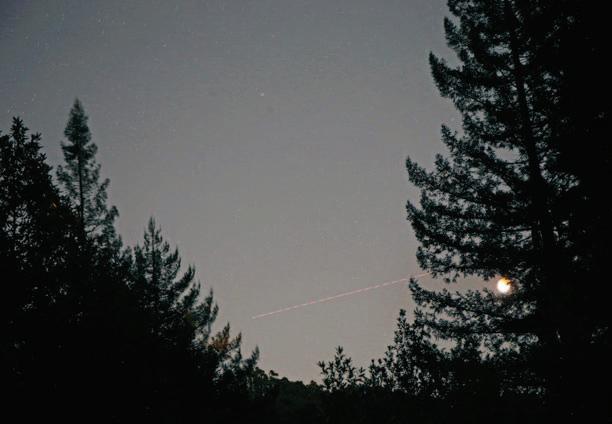
“Space changes nobody,”the Apollo 14astronaut toldauthor Andrew Chaikin in1990.“You bring back from spacewhat you bring into space.”
Histheorywas tested not just on himself, but on the embryo “moon trees” hecarried thereand back. Hundreds of seeds filled ametal canister inhispersonal travel kit forNASA’sthird mission to landonthemoon.
Twoofthemgrewinto coast redwoods thatnow tower atop the Berkeleyhills.Mostly forgotten, except by parkrangersandthe occasional space-buff tourist, they standon opposite endsofTilden Regional Park.
Roosa’s treestuntwas meant to promote theU.S. ForestService, whichonce employed him as a firefightingsmokejumper. Healso hoped to findout howthe seeds would survive zero gravity,radiation and otherperilsoftraveling beyondEarth.
Mission accomplished.
“Yep, theygerminated,”says Bart O’Brien, manager ofthe Regional Parks BotanicGarden in Tilden, whereoneofthetrees is located.“Clearly,bylookingat the tree,therewas noeffect,which doesn’t surprise meatall.”
Farmore challengedby California’s drought than by its lunar voyagenearly45 yearsago,the treeis nestleddeepinside the garden, maintained by theEast Bay RegionalParkDistrict.
“Theseed fromwhichthistree sprang was taken to the moon,” says asign nearthe base of its trunk.
 BYTESACROSSTHEBAY
BYTESACROSSTHEBAY
Astronomicalarbors
Theother moon tree—about 2miles north — is unmarked and harderto find. Just4feet tall when itwas relocatedfromaForest Service nurserytotheBerkeley parkin 1976, it nowoverlooks a meadow near Tilden’sEnvironmental Education Center.
Roosa’s treesarehealthy, O’Brien says.They’renourished by fog dripabsorbed through the needles, andpark rangershave supplemented them with extra water during the drought.
Roosa, who died in 1994, would have beenpleased bythe condition of the Berkeleyredwoods that will likelyoutlive all of the survivingApollo explorers.
Surrounding thegarden’s moon treeis the samevibrant green undergrowth thatdots redwoodforestsalongCalifornia’s North Coast: giant chainferns, leatherleaf ferns, sword ferns, large-leavedlupine, wood rose, Humboldt larkspur,salmonberry,Chamisso’shedge nettle. Its taller neighborsincludeaDouglas fir and an older redwood grove planted inthe1940s.
Although no formal list was kept, moon trees arescattered across theUnited States—from Oregonto Florida—and even as far as Brazil and Switzerland. InCalifornia, moon treeswere planted atHumboldt State, in Arcata; MissionPlazain San Luis Obispo; FriendlyPlazainMonterey;CapitolPark inSacramento; andseveralother locations.
NotallofRoosa’s seeds — whichincluded redwoods, firs, sycamoresand sweetgums— fared so well as they were gifted to parks and set roots around the United States. A loblolly pine planted atthe White Houseno longer stands, and Idahovolunteers this fallwerefightingto save aheat-stressed and bug-infested pine inBoise.
At left: Visitors tour theRegional Parks Botanic GardeninTilden. Center,clockwise fromtop: A moon tree,the redwood second from left, stands tall as asupermoon lunar eclipse peeks between the branchesof another tree at Tilden Regional Park; inthis long-exposure photo,the moon illuminates thick fog as deer roam the park; anew branch sprouts fromthe roots of a redwood tree;aplaque identifies a moon tree.

33 BAYAREANEWSGROUP AHA!
ALAMEDACOUNTY ||| STORYBY MATTO’BRIEN ||| PHOTOGRAPHSBY RAYCHAVEZ

 Amoontree, the redwood at center,stands next to the main entrance of the Environmental Education Center at Tilden Regional Park.
Amoontree, the redwood at center,stands next to the main entrance of the Environmental Education Center at Tilden Regional Park.
Man walks into abar.From there, thestory getsfuzzy. Makethat “stories.”There are multipletheories on where themartini,thatelegant cocktail of dry-wittedsophisticates, was born. Italy. NewYork. San Francisco.
Martinez, thecounty seat of Contra Costa, has the most credible claim. Make that “claims.” They all begin circa 1870,withagold miner fresh fromthe foothills and clutchingabag of goldnuggets walking into theRichelieu Hotel and asking bartender Julio Richelieu for somethingspecial.
Richelieu madewhat he called aMartinez Special —apotent blendofgin, vermouth, a dash ofbitters and an olive.Thegold miner lovedit.
“Thenamewas changed because after youhad afew,it came out‘martini,’”says Angelo Costanza, aMartinez-based attorney whoseparents wererestaurateurs in thecity fornearly half a century.“Martinez became known as the home ofthe martini.”

Insome versions, theRichelieu was locatedat414 FerrySt.,where theRoyal Thairestaurant now stands. Inothers, theRichelieu was atthe cornerofAlhambra Avenue and MasonicStreet, whereaplaque identifies the site as “Birthplaceofthe Martini.”
Insome versions, thegoldminer asksRichelieuforChampagne, only to be told none is available. Inothers heasksforwhiskey, whichhe chaseswith Richelieu’s improvisational genius. What’s indisputable is how thedrink became part ofthe city’sfabric— in September, Martinezexpanded itsannual MartiniFestival into a MartiniMonth.
“In the’40s,’50sand ’60s, there was the MartiniNavy,”saysTom Greerty,anattorney and Martinez city historian. “There wereno
TheMartinezSpecial
ships. Buttheyhad a flag, admirals, certificates. Richard Nixon was an admiral. This was a wayfor politiciansto laugh and enjoy stories about the martini and also to focus onthe need foranew bridge acrossthe Carquinez Strait.It was asocialclub.But it was serious.”
Greertysaysthe MartiniNavy occasionally would setsail for Sacramento bearing “copious amounts of gin and vermouth” to lobby for the span.
Morerecently,it issaid that importantcourts-related business was conductedatAmato’sRestaurant, whichalsowas located at 414 FerrySt.,withthe aid ofthe cocktail’ssoothinginfluence.
Thebiggest challengetowhat Martinez residents consider their rightful heritage came from San Francisco andwas fueledby Chronicle columnist and martini enthusiastHerbCaen. In1983,the San FranciscoCourtof Historical Reviewheld a mock trial, which ruled that thedrink originatedin the city.

Shortly thereafter,aMartinez mock court, setting up shopin the CityCouncilchamber,overturned the San Franciscoruling. Colorful local attorney BillGlassrepresented Martinez.
“Bill was particularly persuasive,”Costanza says.“He called on the ghostof Julio Richelieu. He established the casethrough Julio himself.Needless tosay,Martinez won thetrial.”
Asin the SanFrancisco proceeding,martinis wereserved.
“I know the judgedid drink one … or more,” saysRuss Yarrow, who coveredthe event forthe Contra Costa Times.
Caen was unmoved.
“Thepreposterous talethat the birth of the martinihad something to do with Martinez,” he wrote, “livesonlikeastrong hangover.”
Bartender Eugene Atkinson makes a martini at Nu-Rays bar in Martinez. RebuffingSan Francisco’sclaim to thecocktail, seen at right, Martinezcites agoldminer as the first to tastea MartinezSpecial —apotent blend of gin,vermouth, adash of bitters andanolive.In someversions of the tale, the drink was made at the corner of Alhambra Avenueand Masonic Street, where a plaque, at bottom left, identifies the site as “Birthplace of the Martini.” Other storiescite 414 Ferry St., where the Royal Thai restaurant, at bottom right, now stands.

36 AHA! BAYAREA NEWSGROUP
BYTESACROSSTHEBAY
CONTRACOSTACOUNTY ||| STORYBY GARYPETERSON ||| PHOTOGRAPHSBY DOUGDURAN


CharlesMartin’snamehas all but vanished among thepastoral, straw-colored valleys of WestMarin. Butthe man who emigratedfrom aforsaken Swiss village in the 1850sas a teenager hasleftalasting legacy. Squint hardenoughasgolden rays slice throughheavenlyChileno Valley onanautumn morning, and it’spossibletoimaginetheghost of Martin (neeCarloMartinoia) roaming thelandscape likea prowlingcougar.
Marin County was a primary destinationfor Martin and other Swiss-Italian immigrants from thesmall cantonof Ticino, where about 27,000 fled Europefor Australia, South Americaand, eventually, California.These Swiss forebears havepassed downto their offspring afarming tradition thatflourishestoday with big-cityappetites fororganicand farm-to-table food. The Bay Area’s agriculturalheartpulsates through this landofPacificbreezes and cottony puffsofmorningfogthat still is workedby the familiesthat originatedfromthe craggyAlpine valleys of southern Switzerland.
AsaPeaceCorpsvolunteer in herearly 20s,SallyGale had romanticnotions about taking her own placeamongthose faraway blond hills whereher multitude of cousinsworkedthe land.
“Youwouldgoover ahill, and they wereeverywhere,” saysGale, afifth-generation Martin. “I was fascinatedbythem.”
In1993, Gale returnedto the ranch ofher great-great grandfather,who had Anglicizedhis name as CharlesMartin. The Martin name has disappeared fromthese partsbecausethe men inthe line eventually didn’tpass italong. Instead, names suchasDolcini and Lafranchi have enduredthrough themarriage of Martin women.

Gale, 73,and husband Mike
 BYTESACROSSTHEBAY
BYTESACROSSTHEBAY
Marin’slittleSwitzerland
operateone of15 Martin family ranches still in existenceinthe arresting, oak-dotted hillsidesfrom Tomales to Petaluma to Novato. Theyare butone extended Swiss familywhoseorigins are traced to Ticino. Others from neighboring Alpine villages also settledhere, includingthe Grossis,whose holdings includefour ranches within Point ReyesNational Seashore.
TheGales are typicalofthe latest generation of caretakers.They inherited Chileno Valley Ranch, nearPetaluma, whereMartin settled in 1862.When the Gales arrived22 years ago,the once-grand house was dilapidated. Ittook five years of labor and all of their moneyto restore the 1883 Romantic Italianate home where Martinlived with hiswifeand seven children.
TheGalesoperatedabed-andbreakfastto generateincome. Then they bought six cows and launched agrass-fedcattlebusiness.


Ralph Grossi, 66, grows pinot noir grapes onhisestate in Novato, next doorto thefamilydairy. Heleftthe dairy businessin the 1980s tobecome the face of the American movement to preserve farmland. Hehelped startthe Marin Agricultural Land Trust, whichhas worked to save48,000 acresof farmland ownedmostly by Swiss-Italian heirs.

“Youinherit thisland, but you also inherit an obligation tomake it lastandto passit on tothe next generation,” Grossi says.

Sally Galealso is an activemember of the landtrust,whichhelped her restore theranch nestledin apicturesque valleynamed for Chilean cowboys who worked here when these homesteads werepart of Mexicanland grants. The Gales have three kids whocould someday make a fortuneby selling theranch.
“But what’smoney?”SallyGale asks.“Moneyispaper. Land is forever.”
Leaves rustle in Chileno Valley; ayoungBlack Angus roams the hills; Gale cares for her mother, Anita Dolcini Googins, 98; the Galeshave 400 organicapple trees; a string of lights hangs in ahistoricdairy barn; ananimal skull decorates afence post;a rusty license plate fromaFord Model T is nailed to a barn wall; a barndoor hinge shows its age.


39 BAYAREANEWSGROUP AHA!
At left: Sally Gale, posingfor aportrait, looks outthe window of her two-story home atChileno ValleyRanch in Petaluma. Center,clockwise fromtop left:
MARINCOUNTY ||| STORYBY ELLIOTTALMOND ||| PHOTOGRAPHSBY JIMGENSHEIMER
 As her husband, Mike,drives, SallyGale tosses hay out theback of theirpickup trucktofeed cattle at Chileno ValleyRanch near Petaluma.
As her husband, Mike,drives, SallyGale tosses hay out theback of theirpickup trucktofeed cattle at Chileno ValleyRanch near Petaluma.

Inthe gardening world, it’srare for customers to walk into a greenhousewith a Broadway show on theirminds.
Thenagain, this nursery inthe Sonoma County town of Sebastopolis highly unusual.
“Where’sAudrey?”visitors ask in jest, evenasthey’rescanning theotherworldlyplants atCalifornia Carnivoresfor agenetic relativeofthe largestandmost famous carnivorous plant of all— thebloodthirsty,boyfriend-eating Venus’ flytrapfrom the enduring musical “LittleShopofHorrors.”
Oh, owner PeterD’Amato has plentyofVenus’flytraps, for sure, but nonewithAudrey’sgirth or, forthat matter, herappetite. Butthankstohis playfullydark senseofhumor, Audrey’skin do have names — ones thatreflect their penchantfor trappingand devouring flies, gnats, mothsand beetles. Oneshowy plant he cultivatedis called Abandoned Hope; another isnamed Splatter Pattern.
Hewill patiently explain to shoppers thattheseplants don’t hunger forhumanflesh andwon’t snare thecuriosity-seekersor gardeners who find this nursery along the Old Gravenstein Highway.Turns out thosesigns urging visitors not to touch the Venus’ flytraps are for the plants’ protection, not yours.
It’sthe first ofmany myth-bustinganswersthatD’Amato and his staffwilldeliver on anygiven day.If youare interestedinthefascinating world of carnivorous plants, this notedhorticulturalist’ssanctuary is theplacetogo.California Carnivores isthe largestsuch nursery in the United States, perhaps the world, withD’Amatocultivating and raising plants here since 1989. Tensof thousands of plantschange hands — safely! —everyyear. A small flytrapcosts $10;rare,colorful, large or older cultivars start at
Bloodthirstybotanicals
$15 and run asmuch as$60.
He’sbeen an aficionado since he was ayoungster,havinggrown up inone ofthe cradles of carnivorous plantdom. That wouldbe … the Carolinas. See?Anothermyth busted.Venus’ flytraps are native to only oneplace in the world, andit’snot an exotictropicallocale. It’sthegrassy wetlands within a 75-mile radius of Wilmington, North Carolina.
Backthen,carnivorous plant hobbyiststended tobe arare, mostly male species — scientists, professors, boys whosentaway for 99-centplants advertised in comic books.

In recent years,the Internet andglobal tourism have helped spread thegospel of pitcher plants, bladderwortsandsundews.Fans of botanicals goon world expeditionstofindnewspecies, and women have joined the clubin big numbers. “Half of our customers thesedays are women,” D’Amatosays.“It’sbeen one of the most dramaticchanges I’ve seen.”
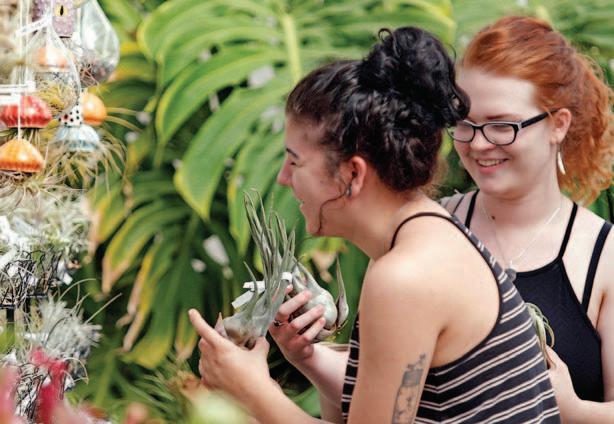

What’sthe appeal?
“It’sreallytheway the plants look, their beauty,”D’Amato says, amid abackdrop of burgundy-rimmedleaves, celadon-colored flutes, dark purple pouches, translucent white flouncesand brightgreen spikes.


Once hookedon carnivores, however, customersare“rather flabbergasted by the volume of insects theycan catch outdoors,” he says.In fact, that’swhy mostof the female shoppers—whooutnumber the men this particular afternoon — are here.
Right outside the nursery,the insectsare active. An orange butterfly alights on a leafy plant. Itwillbe safe; carnivores rarely catch them.Thatpeskyfly buzzing aroundthe parking lot? Depends. Itneeds tohead away now, lestit become Abandoned Hope’sdinner.
Clockwise from top left: Air plants usually growattached to other plants, without soil; Venus’ flytraps are sensitive to touch and require their would-be victims to stimulate two trigger hairs before they clamp shut; Emily Felch, left, and JordanClark, both of Reno, investigate air plants; pitcher plants hold anectarthat intoxicates insects, easing the long slide down toacertain death; sundews use their glands to digest insects. Atright: Sundewshave thin,hairy leaves that curl up likefiddlehead ferns to capture tiny prey.
42 AHA! BAYAREA NEWSGROUP
BYTESACROSSTHEBAY
SONOMACOUNTY ||| STORYBY LINDAZAVORAL ||| PHOTOGRAPHSBY RAYCHAVEZ

 BYTESACROSSTHEBAY
BYTESACROSSTHEBAY
WhenOldFaithfulturnsfaithless
The loveliestearthquake detectorin California lives in the plainest ofplaces: a hole in the ground. Forfiveto55 minutes, youponderasmall rocky fracture — thensuddenly thrill to the spectacleof Calistoga’sOld Faithful Geyser, spoutingagraceful veilofsteamandhot water 20 to 80 feetinto the air.
Butif OldFaithful turns fickle —say,your waitdrags on an hour or more—there could be trouble brewing inits undergroundplumbingsystem. Hereinearthquake country,that’sneveragoodsign.
Such mysteries have long entrancedvisitorsofthis scenic little town at thenorth endofNapa Valley.TheWappoIndiansjourneyed here to ease achesand painsinits warm, mineral-rich waters. When businessman andpromoterSam Brannan arrivedin Calistoga inthe 1850s,he envisionedaSaratoga HotSpringsoftheWest.
Longbeforeit becamefamed for wine, theregion was known for such mysterious geology.“The wholeneighbourhoodof Mount Saint Helena isfullofsulphur and ofboiling springs, …and Calistoga itselfseems toreposeonamere filmaboveaboiling, subterranean lake,”marvelednovelist and poet Robert Louis Stevenson,in his book “The Silverado Squatters.”
Old Faithful traces its creationto that era,whenanill-fatedwelldriller inthe 1880shappened tostrike a deep magma-heatedreservoir.(But itseruptionsare all-natural,driven by escaped pressure initsunderground hydrothermalchambers. There are plenty of geysers inthe world, but only three—Yellowstone’sOld Faithful and thePohuto Geyser in NewZealand are the others —have the “Old Faithful” designation duetotheirregularity.)
Otherearthquake-detection systems relyontechnology,such as sensors to feelseismicwaves
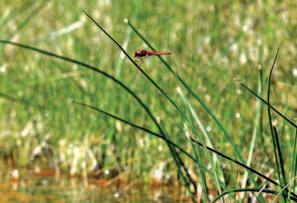
andcomputers to transmitdata to an “alertcenter” for messaging to phones. OldFaithful, in contrast, offers a vistaofMountSt. Helena andarugged,mile-long volcanic wall, Palisades. Overtime,the 6-acre park, beloved mostly for its roadside kitsch, fellinto disrepair.

ButOld Faithful isin new hands. (Yes,you can buy a geyser.)
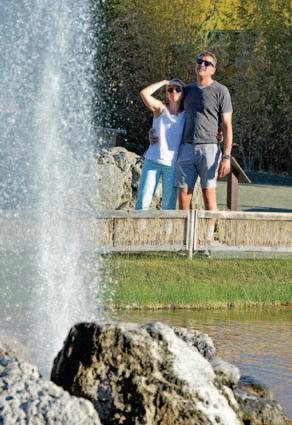
Tech-savvy owner KoraySanli, creatorof thetrip-planning Internet portalsDestination Intelligence, bought thepropertyin 2013 and hascommitted the sitetoscience.
Itnow features a small geology museum that describesnot only geysers,butother aspects of our roiling earth,such asearthquakes, volcanoesand tsunamis. It’s hungontoafew of itsBarnum &Bailey-likeoddities: Tennessee “fainting goats,” born withahereditarydisorderthat causes muscles to stiffen when startled, and Jacob four-horn sheep, whichsport horns out of the sides oftheir heads.

Butit’sthecreepystuffwe can’t seethatdeservesfull attention.Geologistsworryaboutstresses that cause deformation in the Earth’s crust, easing pressure inside the geyser’sreservoir and delaying the timebetween eruptions.
Research shows that Old Faithful’seruptions lengthened significantlyadayorsobefore threelargeearthquakes inNorthern California: the magnitude-7.1 LomaPrieta temblor in 1989, a 5.7 Orovillequakein 1975, and the 6.1 Morgan Hillquake in 1984.(It’snot perfect: Sometimes eruptions slow when earthquakes don’toccur.)
Ittook morethan an hour to eruptin August 2014—the day beforethe major 6.0 Napa quake —“soweknew itwas something strange,”Sanli told TVreporters.
WhenOldFaithful grows faithless,it’stime tocork thewine, fold up thepicnic blanketand head home.
At left: Calistoga’s Old Faithful usually spouts every five to 55 minutes, depending on the season.Center, clockwise fromtop: Luna Huckabee, of Los Angeles, feeds agoat; LeanneSkudrna, of San Francisco, andPaul Bartolotta, of Vallejo, watch an eruption;a dragonfly hovers above the water; the hillsbehind the attractionare bathedinsun andshadows.
45 BAYAREANEWSGROUP AHA!
NAPACOUNTY ||| STORYBY LISAKRIEGER ||| PHOTOGRAPHSBY DOUGDURAN
BYTESACROSSTHEBAY
Thesecretsbehindthesweets
The number of jellybeans— 15 billion! — gobbledupin any given yearwould circle theEarth 5½times.Clearly,most of us have zerocontrol when it comes to the kryptoniteof thecandy world. But how manyofusknow wherethejelly bean comesfrom?
If you wantto consideryourself atrueconnoisseur of theconfection, you can takeacrashcourse atone of the candy’smeccas — theJellyBellyfactory inFairfield. There, you’lllearn thatjelly beans have anancientpedigree. Experts think theymay be a mashup of twocandies,Turkish delight,with itschewy fruit center,and Jordan almonds, withtheircrunchysugar shells. Put them together,and youhaveatreataddictive enough that Boston candymaker William Schrafft urged allgoodAmericans to send them to theUnion soldiersfightingin the CivilWar.
By the 19th century,jelly beans werewidely consideredaclassic pennycandy. Intheearly 20th century,“jelly bean” was aslang term for a snazzilydressed man with an eyefor the ladies.Notuntilthe 1930s did these brightly colored balls of sugar becomeassociated with Easter, perhaps because they resemble eggs, whichare symbols of fertilitymeant to evoke the promiseofspring. Five billion Jelly Bellys (which come in 133 flavors) are sold atEaster alone.
Butin the 1960s, the beans reallyenteredthe limelightwhen CaliforniaGov.RonaldReagan madethecandies cool in pop culture. Hegothookedonjelly beans whenhequit smoking;by thetimehebecame president,he was a full-blown fanatic. Indeed, Reagan was so in love with Jelly Bellysthathe madethemthe first jellybeans in spacebysending them along onaspace shuttle Challenger mission in 1983. The Gipper’slove forthe candy is so

legendary that there’seven aJelly Bellycollage, involving no fewer than 17,000 beans, ofhiskisser on displayat thefactory.
Indeed, aspecial flavor(blueberry) was minted inhonor of his presidential inauguration — 40 million beans were nibbledat the celebration —so theywould be ableto make ared, white and blueJellyBellyflag.
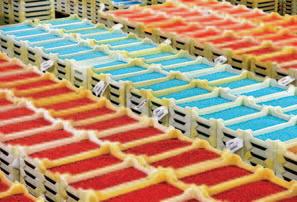
Certainly,there’sascienceto cooking up the perfectjellybean, whichtakesabout sevento 14 days from startto finish.The Jelly Bellycompany,whichhasbeen plying its trade since 1898, has a lot of trivia to shareasyou stroll along thequarter-milelong conveyorbelt for its famous tour.
Thefactory,whichoperates 24 hoursaday,five days aweek, is acolossal candybeehive humming withworkers, robots and machinesturning sugar,fruit and other ingredients into jelly bean bliss. Theprocessis complex,with top-secretrecipesinvolved, but the magicofit all is coatingagooeygobofgoodness with a perfect sugary shell through a technique knownaspanning. About 1,680 beans areproducedper second.
Almost 362,880pounds of jelly beans areproducedper day (that’s as heavyas24elephants), but the company isastill astickler for consistency.If a bean is too small, too large or not perfectly coated, it is rejected from the assembly line. These flawed beans find their way into the discounted Belly Flops productline.

If allthat trivia makes you peckish, restassuredthere are also severalchances tosample the goodswhile yougawk at thetiny candy gems. But beware the gag flavors, suchasbarfand boogers. Forthose who worryabout overindulging,take heart in the sweetest factof all:Theaverage JellyBellyhasonly four calories.
An estimated 600,000 jelly beandevotees taketheJelly Bellyfactory tour every year to bone up on beantriviawhile frolickingina brightlycolored wonderlandof decadence.Atleft: The candydrops from aconveyor belt, isassembled into aportrait of RonaldReagan andlies in trays, as partofthe curingprocess. At right: Barry De Silva,of Fairfield, makes grape sodaflavored beans.
46 AHA! BAYAREA NEWSGROUP
SOLANOCOUNTY ||| STORYBY KAREND’SOUZA ||| PHOTOGRAPHSBY DOUGDURAN

BRAINGAMES
It’sno longeraplaceforskating, splashingorseeing amazingartifacts. Whereare you?Here’saclue togetyou started: Thefacility,developedby aself-made millionaireandbuilt in the1800s, wasdestroyedin a fire.Itnow ispartof anationalrecreation area.

48 AHA! BAYAREA NEWSGROUP
PHOTOGRAPH FROM GOOGLE EARTH FINDTHEANSWERON PAGE82
VISUAL SURPRISES
SEVENNOVELGRAPHICS
INVENTEDHERE
Althoughaccountsvary,the now-ubiquitousfortunecookie probablywasintroducedto SanFranciscoabout1920.The confectionsmayhavebeen inspiredbythepracticeof Chinesesoldierspassingsecret messagesincakesinthe1300s.
 PHOTOILLUSTRATIONBY DOUGDURAN
PHOTOILLUSTRATIONBY DOUGDURAN
VISUALSURPRISES
Settingthe recordstraight
Everyone hasseenthe famouslywinding Lombard StreetinSan Francisco,whichisthe city’smost crooked street—right? Wrong. LombardStreet between Hydeand Leavenworth isthe prettier, ritziercousin of VermontStreet, whichholdsthe distinction of being the actual crookedest street, according to the San Francisco Department of PublicWorks, which cites thesteeper grade, tighterturningradius and fewer turns (Lombard haseight,while Vermont hasseven). ThebrickpavedLombard Streetmay getall the attention (haveyouever not seen a hordeof people there?), butthe dubious distinctioninquestion is held by Vermont Streetbetween 20th and 22nd streets.

ILLUSTRATIONBY CIARAPHELAN

VISUALSURPRISES
Whatlies beneath
“Howshallow!” is an expression thatcancome up a lot when living in theBayArea,but in no instance isit moreappropriate thanwhen talkingaboutthebelovedSan Francisco Bay. Theaveragedepthofthebayis about the same as thatofabigswimming pool—anaverage of 14 feetdeep, according toThe BayInstitute. Underwater channelsaredredgedtohelp prevent largevessels fromrunning aground. Notall ofthebay is soshallow,though. NeartheGolden GateBridge,the watershave depths ofmorethan300 feet,for example.
Depthofthebay

San Francisco Alameda Oakland Hayward Union City Newark San Mateo East Palo Alto
Pittsburg Concord Benicia Vallejo Novato Richmond Tiburon
GRAPHICBY DOUGGRISWOLD
0-10 feetdeep 10-30 feet deep Deeperthan 30 feet
PHOTOGRAPH BYRAYCHAVEZ
SOURCES:NOAA,U.S COASTGUARD,U.S.ARMY CORPS OF ENGINEERS
How dredging works
1
Ahydro-survey is conducted to determine how much silt andsediment shoaling has occurred and impedes into the channel.
2
Dredges remove the material. Ahopper dredge employs a trailing suction pipe;aclamshell dredgepicks up material with a clamshellbucket.
3
Dredged matter is tested for hazardousmaterials. Manyhazardous substances are naturally occurring, and others come from waterrunoff.
4

The nonhazardous dredged material is transported anddisposed of at several sites around the bay oratadeep ocean site.
5
Anew hydro-survey is conducted to verify the channel is clearofsilt and sediment and the waterway is navigable.
VISUALSURPRISES
Aviewfromthetop
Withasummit3,849feetabovesealevel,MountDiablostandslikeasentinelwatchingovertheBayArea.Theviews fromthetoparearresting—infact,onaclearday,youcanseepartsofawhopping35of58Californiacountiesfrom thesummit,accordingtoDanStefanisko,supervisingrangeratMt.DiabloStatePark.Whentheconditionsareideal (thebesttimeforviewingisinthewinterorearlyspringafterastormhasclearedtheskies),youcanseenearly200miles. Tocheckoutthelandmarks,headtotheobservationplatformoftheSummitBuilding,andlookwesttowardtheparking lotandcommunicationtower.Duringprimevisibility,thelandmarksthatcanbeseenincludeLassenPeak,inShasta County;HalfDome,inMariposaCounty;andtheFarallonIslands,partoftheCityandCountyofSanFrancisco. Althoughyoucan’tseeMountShastadirectly,youmightbeabletoseepartofthepeak,refractedbytheatmosphere.
ILLUSTRATIONBYDAVEJOHNSON

MountLassen 165miles Elev.10,466ft. MountShasta 240miles Elev.14,151ft.
MountSt.Helena 67miles Elev.4,344ft.
SOURCES:MT.DIABLOSTATEPARK,CALIFORNIASTATEPARKS
 MountTamalpais 43miles Elev.2,601ft.
FarallonIslands 60miles
TheDelta 20miles
YosemiteValley andHalfDome 135miles Elev.8,839ft.
MountHamilton 40miles Elev.4,200ft.
LomaPrieta 58miles Elev.3,791ft.
Mount Diablo Elev.3,849ft.
MountTamalpais 43miles Elev.2,601ft.
FarallonIslands 60miles
TheDelta 20miles
YosemiteValley andHalfDome 135miles Elev.8,839ft.
MountHamilton 40miles Elev.4,200ft.
LomaPrieta 58miles Elev.3,791ft.
Mount Diablo Elev.3,849ft.

VISUALSURPRISES
Offthewall

TheEaster Island statues. Stonehenge. BerkeleyMystery Walls? Thegeneralpublic might not knowmuch about thewalls thatstop and startacross the landscape inthe BayArea and are thesubject of tons of speculation. Were they madeby aliens? Aretheyrelics from survivorsofalost continent? Itturns out,they’re not much of amystery,according to Beverly Ortiz,cultural services coordinator with the EastBay Regional ParkDistrict. “Wejust callthemrock walls,”shesays.Analysis placesthemin theearly American era—the one picturedatleftdates back to asearly as 1851 — whenEuropean settlers aresaidtohavebuiltthewallsusingthe labor of marginalized groups,suchas theChinese andNative Americans. The walls were used mainlytoclearland ofscatteredrocks to facilitate the movement of grazing livestock, such ascattle,and,attimes, to guide the movement of the animals or tocorral them. Sotakeoffyourtinfoil hats:Even thoughthewalls don’t, infact, haveotherworldly origins, they provide a snapshotoftheBayArea’srural past.

57 BAYAREANEWSGROUP AHA!
PHOTOGRAPHSBYDAISUGANO
“Mystery Walls”haunt Bay Area parks, includingan East Bayregional park, left, andEdLevinCounty Park, in SantaClaraCounty, above.
Thembones
Forgetabout skeletons inthecloset—SanFrancisco’sCalifornia AcademyofSciences hasskeletons on its roof. That’s right:Thelivingroof,mostlycovered with2.5 acres ofhills andnative California plants,also is hometowhale bones,which are placed there for degreasingvia natural forces such as wind, rainand sunlight.Thisis just onemethod thatacademy researchers usetocleanand preparebonesbeforethey becomepartofscientificcollectionsorexhibits.Thisprocess also allows researchers tostudy a specimen’slifehistory,including itsdiet andage.Thelocationofthese bonesonthe roof canvary,but visitorsusually canseesome ofthe larger bones from the main roof observation deck. The jawbonesof a 49-foot sperm whale tookresidence on theroofafter the animal washedup inPacificainApril.Here’salookathow theacademy’s processworks:

58 AHA! BAYAREA NEWSGROUP
VISUALSURPRISES
ILLUSTRATIONSBY JEFFDURHAM
The bones are transferred from the beach. Thetwo spermwhale jawbones, togetherweighing700 pounds, werecarried upthe beach inatarp by ateamof17.The mandibles thenrodeona truckupthehighway and inthe academy’sfreightelevatorbefore they were hauledup twoflightsofstairs(byhand!) totheroof.

The bones are buried under alargemoundofsoil tolet bacteria andbugs naturallycompost the muscle and gum.The museum’slandscapeteam thenplaces nativeplantson top.The decomposition processcleans thebonesandhelps theplants grow.Bonesgenerally are buriedfrom sixmonths to a year.
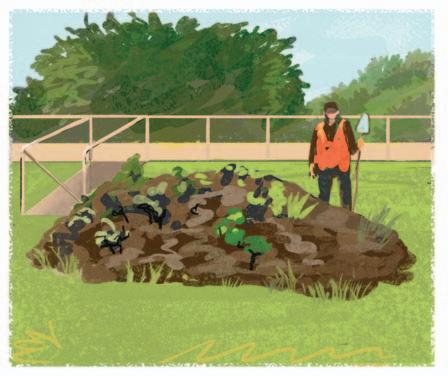
Once the tissue has completelydecomposed andthe bones are clean, they are excavated. Theacademyexcavates the bones carefully —just likeatanarchaeological dig site — so that the teetharenot lost. The processgenerallytakesseveral hours and ahandful of people, butit can vary, depending on thespecimen.



Researchersremove the teeth, cutthem inhalf and examine thelayers todeterminethewhale’sage.Theystudy tiny samples of dentin,acomponent oftheteeth,tounderstandtheanimal’s diet. Onceremoved, teetharestoredin the research collection, makingiteasierfor researcherstostudy them in furtherdetail.
The bones are left on the roof for degreasing and bleaching by the sun. Oilcan leach to thesurface ofbonesoveraperiod oftime. The naturalelements—the sun,wind and rain—that thebones areexposed to ontheroof are parts of the overall cleaning processand help movethe grease out ofthe bone.
The bones usually will jointhe academy’sscientific collection. The museum sometimes leavesboneson theroof for public display.The number of specimensondisplay on the roof varies,but at the time of thiswriting, theacademy had sixsets ofbones, including the spermwhale.

59 BAYAREANEWSGROUP AHA!
SOURCE INFORMATION AND IMAGES:CALIFORNIA ACADEMY OF SCIENCES ALL MARINE MAMMALSTRANDINGACTIVITIES WERE CONDUCTED UNDERAUTHORIZATION BYTHE NATIONALMARINE FISHERIESSERVICE THROUGHASTRANDING AGREEMENT ISSUEDTO THE CALIFORNIAACADEMY OFSCIENCESANDMMPA/ESAPERMITNO.932-1905/MA-009526
VISUALSURPRISES
City ofSouls
Walking in San Francisco’sBuena VistaPark, you mayoverlookthe draingutters.Ifyoucatch aglimpse,you may spot a figure imprintedonthe surface—anumberor a letter hereand there.
“They’rehard to see,but they’rethere,” says filmmaker Trina Lopez. These markings revealthegutters’originalincarnation: Theyweretombstones. “Through laws and referenda, San Francisco hasbasically bannedthedeadfrom itsborders,”says Lopez, whose documentary“A Second FinalRest” explores thetopic. San Francisco hadforbidden burialsalready whenresidents“votedthe dead outofthecity.”Remains atthe BigFourcemeteries —Odd Fellows, Masonic,Laurel Hill andCavalry —wereremoved in the ’30s and’40s and transportedtoColma,which has fewer than2,000 living residentsand about 2million deceased.In additionto being used in gutters, leftover headstoneshavefound new life in AquaticPark’sseawall.

60 AHA!
BAYAREA NEWSGROUP
PHOTOGRAPHSBY JIMGENSHEIMER
Reused tombstones line thepathway gutters at BuenaVistaPark inSan Francisco,andthenameReid can be seen on the seawallatthe AquaticPark.




61 BAYAREANEWSGROUP AHA!
VISUALSURPRISES
Literarylandscape
FromHammetttoHosseini,TwaintoTan,andSteintoStevenson,manyliteraryluminarieshaveBayAreaties. BookwormsfromtheBayAreaandbeyondmaybeinterestedintheselocallandmarks,includingtheruinsofJack London’sdreamhome;apropertyinSt.HelenawhereAmbroseBierce’sfamilylived(it’snowabed-and-breakfast;the author,preferringtobeinadifferentlocationfromhisfamily,stayedatanearbymountainretreat);theHere/Therestatues thatrecallGertrudeStein’sfamousquote;and826Valencia,anonprofitfoundedbyDaveEggersandNíniveClements Calegarithathelpsunderresourcedstudentswiththeirwritingskills.Andeducationalinstitutionsintheareahaveboasted famousstudentsandstaffmembersincludingMichaelCunningham,TobiasWolffandJohnSteinbeck(Stanford);Maxine HongKingston,IshmaelReedandRobertHass(UCBerkeley);andAmyTanandEdwinMarkham(SanJoseState).
ILLUSTRATIONBYJAKOBHINRICHS

FAMOUSHOMES
JackLondon’sWolfHouse(historicparkat2400LondonRanchRoad,GlenEllen); PhilipK.Dick’s“HermitHouse”(707HaciendaWay,SanRafael); DashiellHammett(891PostSt.,SanFrancisco); RobertLouisStevenson(plaqueat608BushSt.,SanFrancisco); HunterS.Thompson(318ParnassusAve.,SanFrancisco);AllenGinsberg (1010MontgomerySt.,SanFrancisco);KenKesey(7940LaHondaRoad, LaHonda);EugeneO’Neill’sTaoHouse(historicsiteat1000KussRoad,Danville); EdwinMarkham(1650SenterRoad,SanJose)

NOTABLELOCATIONS
AmbroseBierceHouse(1515MainSt.,St.Helena); CityLightsBooksellers&Publishers(261ColumbusAve.,SanFrancisco); UCBerkeley(visitorcenterat101SproulHall,BarrowLane,Berkeley); Here/Therestatues(MartinLutherKingJr.WayatAdelineStreet, Berkeley/Oakland);JackLondon’scabin(JackLondonSquare,Oakland); 826Valencia(826ValenciaSt.,SanFrancisco); StanfordUniversity(450SerraMall,Stanford); SanJoseState(1WashingtonSquare,SanJose)
Bendystraws,floppydisks,fortunecookies andice pops—these aren’ttheonly thingsto haveBayAreaoriginstories. Many innovationsandinventionswere born in locations acrossthe region, from SiliconValleygaragesto San Franciscoworkshops to thehillyland oftheNorthBay toeating establishmentsin theEast Bay.Seeifyoucan identify whichfive ofthenine itemsbelow were inventedor introducedin theBayArea.




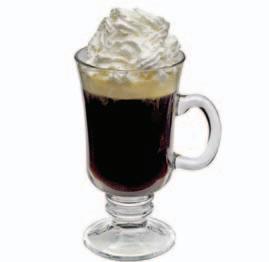




BRAINGAMES PHOTOGRAPHS FROMTHINKSTOCK FINDTHEANSWERON PAGE82
EggowaffleToiletpaperMountainbike
SnowboardTelevisionIrishcoffee
MouseSlinkyPotatochips
INVENTEDHERE
If you thinkyour childis inventive,checkout this kid: At age 11,FrankW. Epperson reportedlyinvented the ice pop (better knownasthetrademarked “Popsicle”) on a cold night in San Franciscoin1905by putting a stick inaglassof powdered soda andwater, then leavingiton his porch(bymorning itwas frozen, accordingtohis Associated Press obituary).But recordsshow it did not get coldinenoughinSan Franciscofor that tohappen, leading some people tobelieve that thebeloved summertime treatwas born in Oakland, the city whereitwaspatented.

TREAT YOURSELF
TWOGOODREADS
PHOTOILLUSTRATIONBY DOUGDURAN

DEFYING GRAVITY
WATERFLOWS—ANDCARSROLL —UPHILLATPECULIARSPOTS
SCATTEREDACROSSTHEBAYAREA

STORYBYANGELAHILL PHOTOGRAPHSBYLIPOCHING
USINGTHEHIPSTAMATICIPHONEAPP
THEREAREPLACES
INTHISWORLDWHERESEEINGISDECEIVING, WHERELOGIC’SLEFTHANGING,ANDSUREFOOTEDSENSESARENOTALWAYSON THELEVEL.
Thisdoes not merely refer to the sensation one feelswhen observingBayArea realestate prices. Rather, we’retalkingabout gravity hills.Sometimescalled mystery roads or magnetichills, suchspots existaround theglobe and righthereat home—eerie locales wherecarsseemtoroll upadownslopeonastretchof countrylane, or water appears to flow uphill, flying inthe face of gravity,causing doubletakes and areflexive “Whatthe …?”
These sitesoften are accompanied by urban legends—wildtheories of magneticvortices,alien navigationaldevices embedded underground or evenghoststories that frequentlyinvolvecrashed busloads of schoolchildren. Scientists, though, saythese socalled anomalies actually are just plain-old opticalillusions, with aconvergence oflandscapecues conspiringtofool the senses.
Whetherphantasm or phantom, thefeeling attheseplaces oftenis fantastic.So getready toexplore far-flung BayArea spots where gravity getssome seriouspushback. If Sir Isaac Newtonwere alive, this wouldprobably kill him.
LET’SSTARTWITH ACLASSIC.
If you’vebeenintheBayArea any stretchoftime, you’velikely felt thepull of thefamed and quirky Santa CruzMysterySpot,an enigmawrapped inariddle and packaged in a45-minutetour.
Asthestory goes, builders back in 1939 surveyedasmall patch ofwoodlandnorth of town, logged unusual readingsontheir instruments, thenfelt dizzy and off-balance. Naturally,theyturned it intoatourist attraction. They

68 AHA! BAYAREA NEWSGROUP
Tourguide Skyler Williams demonstrates the17-degree lean at SantaCruz’sMystery Spot. Previouspage: Acar appearsto roll uphill on Lichau Road in Penngrove.
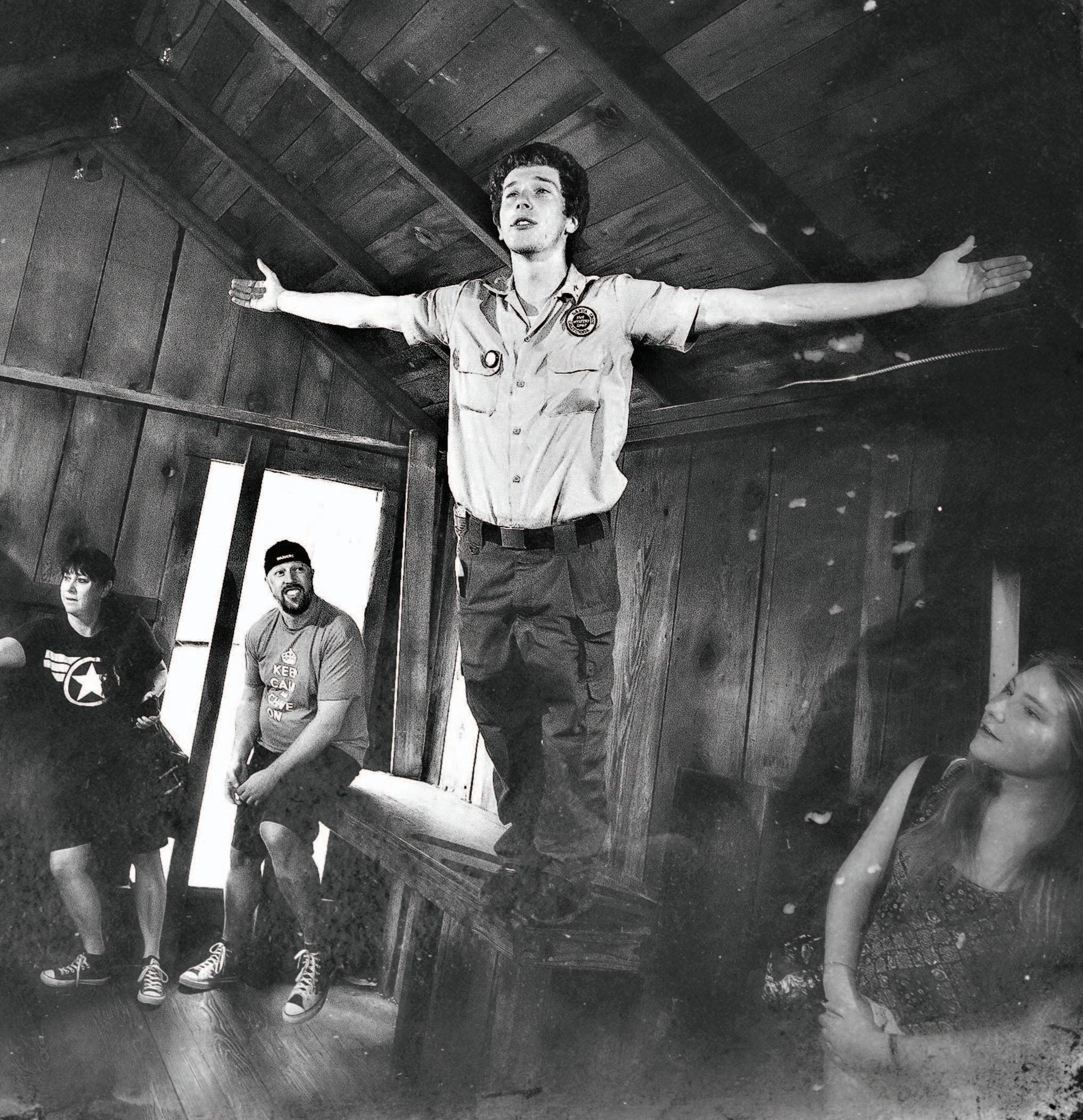
designed anoff-kiltercabin with tilted walls, angledfloors and ceilingsand dubbed ita“gravitational anomaly.”
Now,nearly eightdecadesand azillion bumper stickerslater,the topsy-turvycabin ismore popular than ever. Visitorsbook tickets weeks in advanceorwaitinline for hours —alltowatchabilliard ball roll upadown-slopedshelf and gawk slack-jawedascompanions seem to change heightwhen standing atdifferent points onthe property.
“I personallydon’tbelieveit’s just optical illusion,” saysRachel Miller, tourguide supervisor atthe Mystery Spot. “Thereare so many different aspectswherewehaven’t beenabletopinpointreasonsfor what’shappening.Like, when you’re in thecabin,not onlyare the walls atdifferent angles, but you canfeellike you’rebeing pulled by some kindofforce as well.”

Guidesposit various theories: metal cones buriedasguidance systems for alien spacecraft, carbondioxide seeping from theground,amagma vortex or “dielectric biocosmic radiation,” whateverthatmay be.
“Or it couldbe thatsomewhere aboveusis aholeinthe ozone layerthatbends light andcauses illusions, likeastrawin aglass of water,”Miller says.Maybeyoucan blame thebighairofthe ’80s for that, too.
Tobe sure, theSantaCruzsite involves showmanship and magnifiedmystery.But whatabout outlying aberrations and unexplained propulsion on therandom rural road?
Takethe so-called uphillstream in Golden Gate Park. It runs alongside afootpathon John F. Kennedy Drive nearLloyd Lake in San Francisco. If you headtoward theoceanonJFK,just beyond the ParkPresidio overpass,pause by atall pine tree,and lookto your right. You’ll seeagentle green streamtricklingalongsteadily, and tricking theeye.
Itreallydoes look likethe water is flowinguphill!It can’t be, you say,and you use the“level tool” apponyoursmartphone, placingit on the bankofthe
70 AHA! BAYAREA NEWSGROUP
stream, then on the nearby path. Reason, andyour phone,say thesesectionsof groundboth lean downhill—thepathmore sothan the stream, making the stream appeartogo up — but, well, wow.

EVENMOREASTONISHING arethespotsthat involve a gravitationalsensation for motorists, when you stop atwhat youthink is the bottom of a hill,put your car in neutral and—as if bymagic or spooky spectral boost—the car seems toroll back up.
There’ssaid to be suchasite on EmpireMine RoadinAntioch, famed for its traditional tale of schoolchildrenkilled when their bus skidded off the rain-slicked lane, theirspirits foreverremaining to help stranded driversget back on their way.Evenmoreof atragedy:Thatstretchof Empire Minehas beenclosed for some time (perhaps togivethe ghost kids arest?), so you can’ttry this one by car.But there’snothingto stopyoufrom an experimentwith aball or a skateboard.
Another gravityroad is said to be on Lake Herman Road, in a remotearea betweenVallejo and Benicia. Just off Columbus Parkway,it’s atthebottom of the first hillwhere the roadmergesinto single lanes. This site has been linkedtothe ghost ofavictim of the infamous Zodiac Killer.
Yetanother is on Patterson PassRoad in Livermore, either at milemarker1.57or 7.52, depending on the storyyou read.(Word is, marker 1.57has beenstolen, making it even trickier to find.) This, too, incorporatesaversion of theschool-bustale — the bus gotstuck,kidsgotouttopush, the bus rolledback …you getthe grislypicture.
Adefinitely doable gravity-hill experience is onLichau Road, in the rollingcountryside above Penngrove in Sonoma County. TakeRoberts Road to Lichau, winding around pastacouple
Water appears to flowuphillinastream along JohnF. Kennedy Drive at Golden Gate Park in San Francisco. Opposite: Asign greets visitors at theMystery Spot.
71 BAYAREANEWSGROUP AHA!
of vineyards,acrossarumble of cattle guards and up through oaks and golden brush.Pass Cannon Road, thenreachacrestmarked by an iron arch reading“Gracias Santiago.”Proceeddownthe hill to whatseems to beadip between twoupwardslopes,put your car in neutral, take your foot offthe brake(watchfor oncoming cars, of course),andletanti-gravitydo thework. Itreallyfeelsfreaky. You’dswear you’recoasting back up thehill!
Susan Panttaja, now aperfectly logical geologyinstructor atSanta Rosa Junior College, usedto goto thespot back inher high school days.“My friendsandIwould all driveup to LichauRoadina Datsun 2000 Roadster.When we gotthere,we’dplayDanFogelberg tapes,”Panttaja toldBohemian. comafewyears ago,and recently recalledtheexperience forthis magazine.
Thescience-minded friends also performedvarious experiments — rolling balls and other round items—to test thesocalled gravitationalforces that seemedtomake theDatsunroll uphill. And rather thanciting a crashedschool busas thesource, Panttaja andherpalsknewit was “an accident of topography.”
“Thelines ofthe hills—and thefactthatyou havebeendrivinguphill—give youthe impression, oncethegradebecomes gentler, thatyouarenow on a
The “Portals of the Past” porticoadorns theshoreof LloydLake, which isfed by a stream at Golden Gate Park that appears to flowuphill.
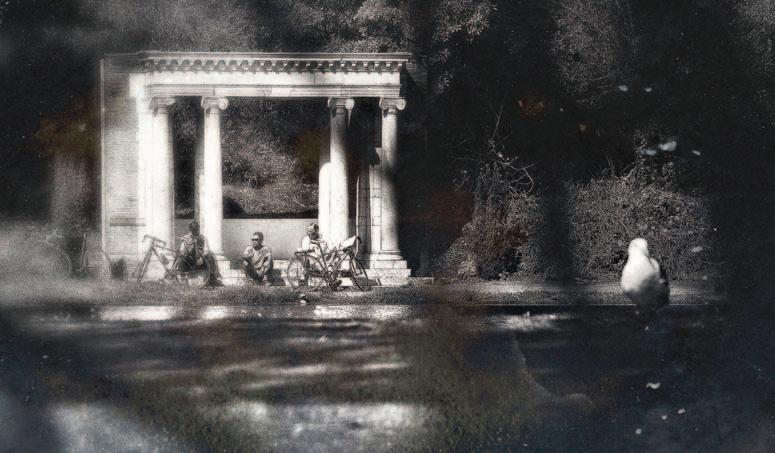
Findingthegravityhills
downhillgrade,”shesays.
LEAVEITTOSCIENTISTS to drag us backdown to earth.
“These are alloptical illusions,” says PaulDoherty,senior scientist atSan Francisco’sExploratorium. “Your eyesand brain use cluesfrom thelandscape to determine your perception of theslopeof a hill.But your eyes and braincan bemisled.”
Heexplains thatall of these places — from thestream in Golden Gate Park to theso-called gravitational effect onLichau Road — have no distant reference points.The truehorizonis shield-
ed, whether bytrees ornearby hills. Inthecase of the Santa Cruz cabin,the sensations occur inside atiltedbuildingwith no visible true horizon.
Asto theoutdoor sites, researchers exploringthis phenomenon havemade scale models of gravity hills,Dohertysays.
“Themodel willhave a miniature road thathas threedifferent sections to it, all atdifferentslopes —asteep downhillslope, then aless downhillslope, and then another steep downhillslope.
“Topeople looking at it—even just atthe model — thecenter
section appears uphill,when it is indeed downhill,becauseyou’re comparingit towhat’saround it.”
Infact, theExploratorium plays this trick on visitorsonadailybasis. IntheVision section, find the Ames Room, originally designed by ophthalmologistAdelbert Ames to demonstrate thisoptical phenomenon. The room is built withdistortedwallsandflooring so that marbles appear to roll uphill, and a person walking into it seemstogrowinto a giant at one end,then shrinks down to the size of a child atthe other.
Butit’sall a ruse on theretina.
“There are ahundred million sensors on your retina,” Doherty says. “So thefirst thingyourretina does isthrow away99 percent of that information, then sends the remaining 1 percent to your brain to make up the restof the story.Basically, whatyou seeis what you think you see.”
Thisvisual bluff oftenhappenstomountain climbers and skiers standing atthebottom of aslope—it alwayslooks steeper than it reallyis. To counteract this perceptualerror, onemethod is to bend over and look atthe slope through your legs, which changesyour normal reference pointsenoughsoyoucan begin to discern the reality.
“Wecallit mooning the slope,” Dohertyjokes.“Youcould tryat the MysterySpot. Then you could be partof theattraction.”
72 AHA! BAYAREA NEWSGROUP
Santa Cruz 1 9 17 Lloyd Lake JFK Dr 4 160 Black Diamond Mines Empire Mine Road 680 780 80 Lake Herman Road Benicia PattersonPass Road Altamont 580 205 Lichau Road Rohnert Park 101
Mystery Spot, Santa Cruz Golden GatePark, San Francisco
PaulDoherty,seniorscientist at SanFrancisco’sExploratorium
Empire Mine Road, Antioch Lake HermanRoad, Benicia Patterson PassRoad, Livermore Lichau Road, Penngrove
‘BASICALLY,WHATYOU SEEISWHATYOUTHINKYOU SEE.’
“Thelinesof the hills—and the fact that you have been driving uphill —give youthe impression, once the grade becomes gentler, that you arenow on a downhill grade,”explains Susan Panttaja, ageology instructor at Santa
 Ahiker walks up the gravity hill on Lichau Road. in Penngrove.
Rosa Junior College.
Ahiker walks up the gravity hill on Lichau Road. in Penngrove.
Rosa Junior College.
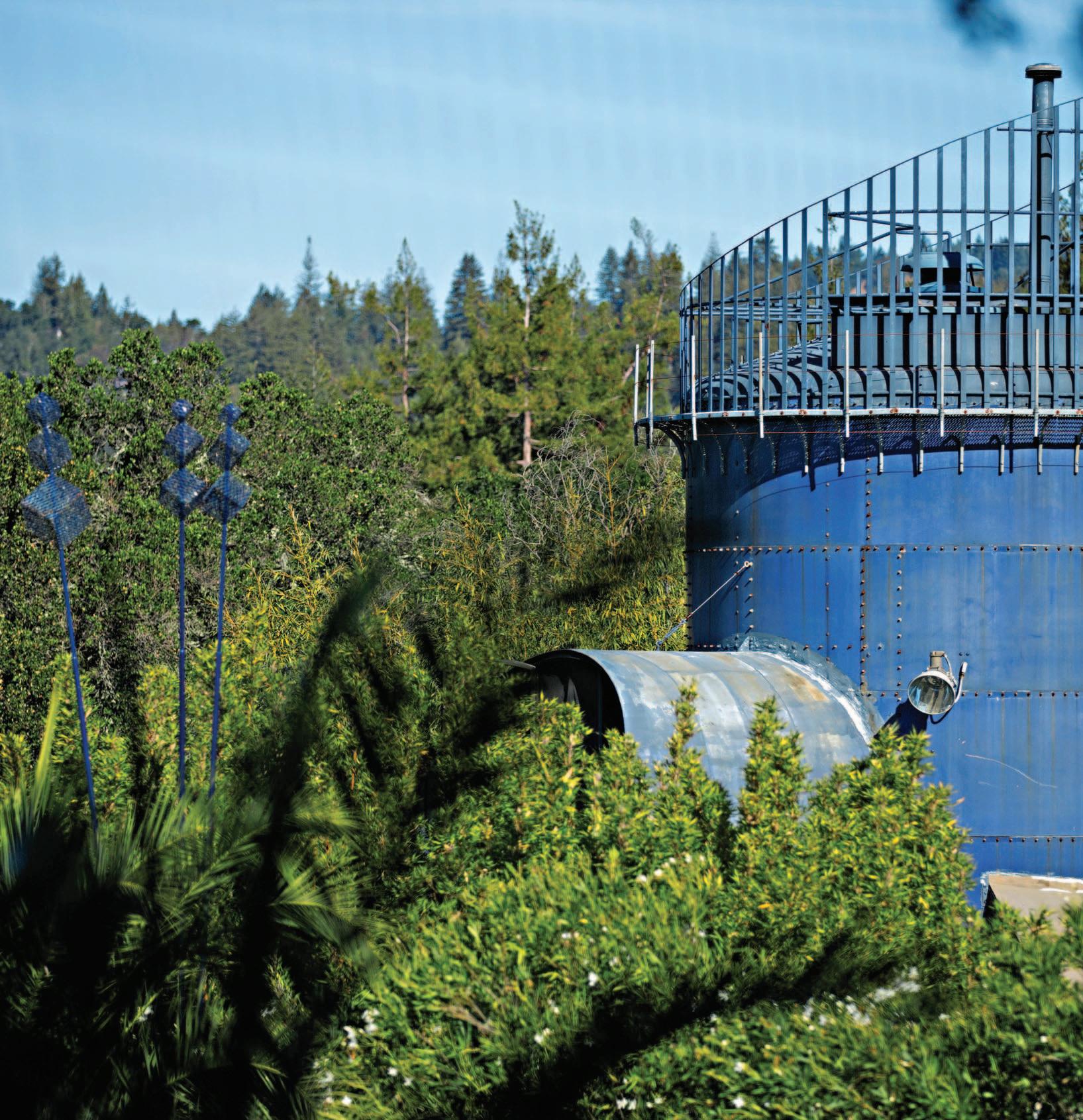

BayAreaabodesstunevenwhen theirmastersremainmum THERE’S LIKEHOME NOPLACE (LITERALLY) STORYBYDAVIDE.EARLY PHOTOGRAPHS BYDAISUGANO
They’reiconic houses, so unique that they live rich, full and fascinating lives on their own —without much assistancefrom owners, gabby tour guidesor real estate agents. TheseBayArea locales quietly thrill visitorseveryday.
Manypilgrimscome tothese surprising housesto gawk and touch familiar memoriesand emotions from films and television.
Themostpopular “house”destination by tourists to SanFrancisco is the “Mrs. Doubtfire”house from the 1993 filmstaring thelate Robin Williams. Today,thestoop is the somber scene of numerous handwrittennotes to the comedian, who died in August 2014.The second most popular housein the city? The “FullHouse”house, despite theABCcomedyshow being off theairfortwo full decades.
Butwithoutany assists from pop/mediaculture, otherspecial structures attractunofficial visitors dailywith architecture that rangesfromstatelyto stark-raving mad. From the wilds of theSanta Cruz Mountains to Alameda Island and on to astaidresidential neighborhood in Berkeley,here are threehouseswith knockout physicalofferings thatentertain on theirown,evenwhen their mastersremainmum.
And, no, you won’tfind the overexposed Flintstone Houseof Hillsborough here. Recently put up for sale — the asking price is $4.2 million—italreadyhas enoughinternational lookie-loo exposure. Too badtheseller,a high-tech executive whoreportedly had a“yabba-dabba-do time” living therealonefor 20 years,refuses to share a single word about that unique experience.
Thetrio ofhouses here maynot be as well-known as theFred-andWilma onejustofftheEugene A. DoranBridge onInterstate280, but theyare justas fascinating on their own.
THESPITE HOUSE IN ALAMEDA shouts out fascinating tales of

The Spite House in Alameda, above left, is 9 feetwide and 60 feet long. An extremely narrow space, shown atright, separatesthe house fromits neighbor.

Previouspage: The Submarine House in the Santa Cruz Mountains is built outofasilo.
rage,revenge, self-destruction and humanspitefulness.
Or not.
Daily curiosity-seekersand schoolkidson an annual field triphead to Alameda to take in thesnarlingbackstory that fuels fascination withthemean-spirited Spite House.
Well…kinda.
Theprickly stories began witha big, beautiful, QueenAnnehouse built in 1880 nearthe cornerof today’sBroadwayand CristStreet. Backthen,it belongedtoAnnette Westerdahl, whosewanderlusting hubby had beengonefor solong, thepoor woman made endsmeet by renting out rooms.
So why do folks come byevery day,staring andstudying?
Because alongsidetheWesterdahlplace is another house with stunning details: It’sonly 9 feet wide and is sitting so (spitefully?) close tothe firsthouse,asugar cubecan’tsqueezebetweenthem.
Itis fromthatcreepycrevice that Spite House lore explodes into anumberof versions thatno one is sure are truth or just plain poppycock.
Thesmallerhouse, plain to see, is ultra-narrow but also is 60feet long and two stories tall—withthe upstairswidth expanding to12 feet.
So why,back in 1908, did thebuilder of thetinyhouse —Charles Froling,acarpenter —construct a lovely,well-built, Colonial Revivalresidence onsuch anarrow slipofland?Andhow could he dosuch a “spiteful” thing,
as hishouse rudely wiped out all thesunlight on the north side of thebighouse, driving Westerdahl’s very upsettenants to moveout and leave her in financial peril?
Over the years, speculation has flown likeshrapnel. Froling was angry atthecity,goesone version, for physicallycarving Crist Street into existence, leaving only a ribbon of soil behind for himto buildupon.
Another story:When Froling was out of town, his conniving brother soldland they sharedto thecity.When he returned,only agash of dirt remained.And yet another talehad Froling ina feudwith Westerdahl so toxic he intended to plunge her intodark madness out of pure spite.
Alameda historian Woody Minor says no oneissurewhich of the many storiesare true, but even107 years ago,they marveled attheconstruction of such a beautiful, oddhouse.
“AnOctober 1908 San Francisco Chronicle storypraised the completion of the house,”Minor says. “But threeweekslater, the Alameda DailyArgus wrote a front-page storyabout thedistraught Mrs.Westerdahl committing suicide.”
TheArgusstory questionedif shehad beendeeply distraught about her long-separatedhusband and, perhaps, bythe new(Spite) house, which had darkened her home, including thedownstairs bedroom where Westerdahl’sbody was found.
Oddly, according toMinor,it wasn’tuntil the1960s that the legendary chatter about “spite” reallystarted.Plentyof rumors also spreadabout both houses being haunted and the scenes of several exorcisms to ridthem ofevil spirits.
Today,the mostinteresting fact might bethat the current owners of eachhouse getalong swimminglyandmostly dismissthe negativenattering.
“I don’tbelieve any of it,”scoffed Robin Coffee,aretired French professor who has lived in the bigger house for six years.She happily
76 AHA! BAYAREA NEWSGROUP


sleeps inwhatwouldbethe haunted, finalWesterdahl bedroom.
“Weheard allthatstuff when we moved in,” Coffeesays aboutthe legends. Evenwithonesidelightblocked,the bigger house today is still bathedin abeatific glow.Coffeehas noproblem withher house being oneofanumber of homes allegedly drenchedin spite.
“Look online, and you’llsee spite housesallover the place,” says Coffee, clackingthe computer in her office, litbythewindowon thefront of her house. Sherattled off spite housesin Alexandria,Virginia; Marblehead,Massachusetts; VirginiaCity,Nevada; Frederick, Maryland; andothers.
Lookingatthescreen, shesays, frowning, “There’smy house,” as shepointstotheGoogle picture of thematching greenstructures. “I still think it’smostly a lot of bad fairy tales.”
Nextdoor,in thehouse of infamy,Jennifer Jacobson also declares, “I don’tbelieve allthatstuff,”even after 18 years ofpassers-bycheckingoutthe place, and noting the Spite House stained-glass window installedin1970—over her front door,at2528 Crist St.
“Alot of people lovethis house,” Jacobson says, “and a lot areassholes about it.”
When peoplecome to gawk, Jacobson says, herfriendssometimes goout and entertain them withmoretales,made up onthe spot — thus addingto theencyclopedic lore.
“I have metdescendantsfrom theFroling family,”Jacobson says, “and theysayhe simply built the house he could afford($2,000). Theysayhe loved thishouse dearly.”
Forher part,Jacobson believes theunusuallytight placementdid lead to aclash withWesterdahl. However,Jacobson posits that Westerdahl’s long-termmarital problems andotherpsychological stresses had more to do with her suicidethan Froling’sfolly.
“My Spite Houseis bothpetite and grand,” Jacobson says proudly of the1,135-square-foot mini-palacewith an impressivecenter staircase that goes upto the second floor. “People are surprised it is notatoolshedor thesize ofa one-car garage. Infact, myhouse is aprettycoollittlehouse.”
THESUBMARINE HOUSE, perched alongtwisty,one-lane Mountain Charlie Roadinthe Santa CruzMountains, is another silentpuzzle: Whydidan inspired sculptor work so hard to construct avisual monstrosity of delight and then refusetotalk about it? Howdifficultit must have beenfor HarryNealIIIto buildanddevelop his subterranean house, overmanyyears, into agiant purple/bluesubmarinein asetting reminiscentofthe 1972 film“Deliverance.”
Tothis day,drivers, bikers, joggers andhikersguffawwhen they suddenly find themselves passing 25015 Mountain Charlie Road in Los Gatos, whereamassive submarineerupts into view, as if rising from an earthen sea through “waves” of soil. Itdelivers awallop of visual surprise.
Accordingto Atlas Obscura—the website that catalogs geographic exotica —in 1973 Neal conscripted afriend to helphim dismantle andtow from San Jose to themountainsasilo onceused for storing hops atFalstaffBrewing. This bit ofinfo came froma one-and-onlyinterviewNealdid withthe Los Gatos Weekly Times.
“Over theensuingyears, Neal turned the silo into his own uniquehomewith circular rooms and a second metal tube withbay windows thatprotrude from the master bedroom, making the silo evenmore ‘submarine-like,’”reads the website, by wayofthe Weekly Times. “Surrounding thehome are a koipond, a hot tub, anda studio forhis bronzesculpture.”

79 BAYAREANEWSGROUP AHA!
Berkeley’sFishHouse wasdesigned to mimic the tardigrade, the most indestructible micro-animal innature. It became knownastheFish Housedue toits circular features.
Today,the househasanew owner, but ahighfenceremains that keeps onlookers atadistance and gives off a foreboding “we don’twant youhere”vibe.And, if that’snot enough, a big,rude, white dogcomesto the fence and barks so harshlythat gettingthe hellout oftherebecomesthe only sensible move.
“Thatdogisone of the most aggressiveanimalsI’veever dealt withuphere,” saysaFedEx driver, preferring to remain anonymous,as one who specializes inrural, mountain deliveries.Although hesees the big blue sub (and thatscarydog) almost daily, whenhe has deliveries attheunique looking house,“Ijust leavethingsat the fence.”
THEFISH HOUSE INBERKELEY might bethecraziest, most visually stunning, iconic BayArea house of them all —andthere are plenty of folks who lovetodiscuss the joys of its undulating architecture.

Thethree youngmen who currentlyliveand work inside the Fish House, hatching what might become ahot, newmobile app, say thehome inspirescreativity.
“I thinkthe light, the aesthetics and eventhe swooping walls make this placeso interesting,” says MarkPaddon, CEOofGuidekick, an application thatbecomes an interactive,3-D directive tobe usedatlocations ranging from museums to state parks.
“This place ishighly conducive to havinggroupbrainstorms,” says Paddon, standing in thesoaring, whirlpool center ofthe silvery white house,which lookslike some giant, mythic sea creature. “Andit isserene and perfectfor programming, writing or designing. Itserves as acocoonthatinsulates us from theoutside noise.”
When architect EugeneTsui (pronounced: Sway) came out of UC Berkeleyin 1989, his firstmajor job was to designandbuildan indestructible,easy-to-live-inhouse for his parents. On a city lotat 2747 MathewsSt.,Tsuicame up with afireproof, flood-proof, quake-resistant, self-heating and -cooling,
Atrioofpeculiar houses
THE FISH HOUSE: 2747MathewsSt.,Berkeley; threebeds; threebaths; 1,948square feet;estimated value is$1,098,010
THESUBMARINEHOUSE: 25015 Mountain Charlie Road,LosGatos; two beds;two baths;1,562 squarefeet; estimated value is $847,204
THESPITEHOUSE: 2528 Crist St.,Alameda; two beds; 1 ½baths; 1,135 square feet; estimatedvalue is $671,470
cavelikedesign.Tsuicalled the house — basedon the appearance of the tardigrade, themostindestructiblemicro-animal innature —Ojodel Sol (the sun’seye).

Butassoon asoutraged neighbors saw theplans—abig, silvery,finnycreature with bulbous, domed-window eyes — they dubbed it the Fish House, a name that stuck.
“Wehadahorribletimethat first yearofputting out the plans,” Tsuisays ofwhatbecame alocal and national controversy over building rights. “There were publichearings till3in the morning filled with veryangryneighbors screaming about not wantingto seethisgiant fish.”
But, somehow,the city approved the wacky plans, andthe otherworldlybeast, withhardly aright angle anywhere,became home forTsui’sparents for nearly 20 years.And, tothisday,their son, with aheadquartersin Emeryville, continues tobolster his wildman reputation for inventive, eco-conscious architecture.
In2014, the Guidekickcrew moved in.Now, all day long, they say,passing cars screech toahalt upon seeingthe house thatlooks like something from thescariest depthsofthe nearby sea. Theysay Tsuiis soin lovewith what they’re creating,thearchitect is giving them a significant break onthe kindof backbreaking rents rampant inthe BayArea rightnow.
Meanwhile, the tenants sayit’s way-cool to be huggedby an interior where a coiling rampreplaces stairs, tentacles are fireescapes, bathrooms suggest phonebooths, shelves float, drawers have wobbly edges,and kitchen countersglide. Sunlight bathes an organic inner space that inspires both deep thoughts andcozycomfort.
“Today,people saytheyseek out this neighborhoodbecauseof theFish House,” Tsui says. “Now, they believethat ifaneighborhoodhas that kindofahouse, the people around here mustbe very interesting. Yes,we now drawa very differentcrowd.”
80 AHA! BAYAREA NEWSGROUP
The Fish House,above and at right, wasbuiltto be afireproof, flood-proof, quake-resistant, self-heating and-cooling structure.
SOURCE: ZILLOW

ANSWERFROMPAGE6
BRAINGAMESANSWERS
ANSWERFROMPAGE24
DIXON SATHERTOWER SMOTHERSBROTHERS ALAMEDA
FINALANSWER: TITANIC
ANSWERFROMPAGE48
Gnome:Page23
Grizzly bear:Page16
Bison: Page 19
Jelly beans: Page 46
Popsicle:Page65
Tombstone: Pages 16,60
AHA!STAFFADDITIONALSOURCES
Art director: TiffanyGrandstaff

Leadresearcher,writer: Tor Haugan
DirectorofPhotography: Jami Smith
Copy editors: Kristen Crowe, Jaime Welton
Story editors: Karen Casto,Mark Conley, Mike Frankel,SandraGonzales,SimarKhanna, Darryl Matsuda,JamesRobinson,LisaWrenn
Redwood:Page32
Martini: Page36
Fairy:Page 11
Football: Page 11
Lightbulb: Page 20
Cat:Page 16
ABOUTAHA!
ANSWERFROMPAGE64
The Eggo waffle,mountainbike,television,Irish coffeeand mouse wereall invented or introduced intheBayArea.Toilet paper, the snowboard,the Slinky and potatochips werebornelsewhere.
7x7;ACLU; AmericanFilm Institute; AmazingList.net; AtlasObscura; BayArea News Group;Boxouse; BurningMan;Business Insider; “Calculating the Sinuosity of Lombard and Vermont Streets,” Ron Lancaster, senior lecturer,OntarioInstitutefor Studies in Education of the University of Toronto; CaliforniaBeat; California Department of DevelopmentalServices;“Capital of theWorld”by Charlene Mires;Cat TownCafe; City of Pittsburg; Collectors Weekly; CowPalace;“Creamy & Crunchy” by Jon Krampner;DailyMail; de Young Museum; EastBay Regional Park District; FoundSF; Gallup;GoldenGatePark; Guinness World Records; HistoryChannel; IBM; Lake MerrittInstitute; Livermore's Centennial LightBulb;KQED;“Krazy George: Still KrazyAfter All These Cheers” byKrazyGeorgeHendersonand Patricia Timberg;Lawrence LivermoreLab’s National Ignition Facility&PhotonScience; Leafcutter Designs; LosAngeles Times; Mental Floss; Mountain View Cemetery; Mt.Diablo State Park; MTV News;Museum ofthe City of San Francisco; NASAAmes ResearchCenter; National ParkService; NBC;NPR;Queerty;Rolling Stone;San JoseEarthquakes; San JosePublicLibrary;“San FranciscoCuriosities” bySaul Rubin; SanFrancisco Examiner; San FranciscoMuseum and Historical Society; SanFranciscoPublic Works; “SanFrancisco’s FillmoreDistrict”by Robert F.Oaks; SanFranciscoRecreation & ParksDepartment;“SilentGesture” byTommieSmith and David Steele; Snopes.com; TempleofPromise; TheAssociated Press; TheAtlantic; TheBayInstitute;TheBeatles Bible; The New Fillmore; The New Yorker;The New York Times; Travel Channel; UnitedNations; UniversityofCaliforniaAthletic CommunicationsOffice; University ofIllinois at Urbana-Champaign English Department; USA Today; U.S.Department of Energy;WeirdCalifornia
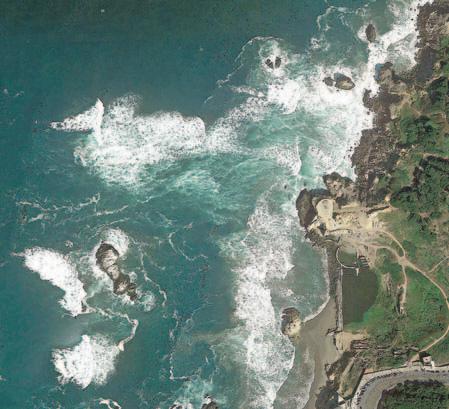
82 AHA! BAYAREA NEWSGROUP
The facilitypicturedhere isSan Francisco’s Sutro Baths.
There are12 hidden pictures in thisillustration,each representing one fact in this magazine.
WINEHAVEN SANBRUNO
JACKLONDON

83 BAYAREANEWSGROUP AHA! AHA!
“Ilearnedto makemymindlarge,astheuniverse islarge,so thatthereisroomforcontradictions.”
Maxine Hong Kingston
As the sun rises,ground fog coverstheChileno Valley.
PHOTOGRAPH BYJIM GENSHEIMER
Makewishescometruefor thoseinneedthisholidayseason.
Lookfor Wishbook2015 starting ThanksgivingDayintheMercuryNews & SharetheSpirit intheContraCostaTimes, OaklandTribune,Daily-Review&Argus.
Todonateonlinevisit: Wishbook.MercuryNews.com or bitly.com/DonateSTS

OFYOURWORLD
MAKINGSENSE




























 PHOTOILLUSTRATIONBY DOUGDURAN
PHOTOILLUSTRATIONBY DOUGDURAN















 BYTESACROSSTHEBAY
BYTESACROSSTHEBAY


 Amoontree, the redwood at center,stands next to the main entrance of the Environmental Education Center at Tilden Regional Park.
Amoontree, the redwood at center,stands next to the main entrance of the Environmental Education Center at Tilden Regional Park.






 BYTESACROSSTHEBAY
BYTESACROSSTHEBAY






 As her husband, Mike,drives, SallyGale tosses hay out theback of theirpickup trucktofeed cattle at Chileno ValleyRanch near Petaluma.
As her husband, Mike,drives, SallyGale tosses hay out theback of theirpickup trucktofeed cattle at Chileno ValleyRanch near Petaluma.







 BYTESACROSSTHEBAY
BYTESACROSSTHEBAY









 PHOTOILLUSTRATIONBY DOUGDURAN
PHOTOILLUSTRATIONBY DOUGDURAN





 MountTamalpais 43miles Elev.2,601ft.
FarallonIslands 60miles
TheDelta 20miles
YosemiteValley andHalfDome 135miles Elev.8,839ft.
MountHamilton 40miles Elev.4,200ft.
LomaPrieta 58miles Elev.3,791ft.
Mount Diablo Elev.3,849ft.
MountTamalpais 43miles Elev.2,601ft.
FarallonIslands 60miles
TheDelta 20miles
YosemiteValley andHalfDome 135miles Elev.8,839ft.
MountHamilton 40miles Elev.4,200ft.
LomaPrieta 58miles Elev.3,791ft.
Mount Diablo Elev.3,849ft.


































 Ahiker walks up the gravity hill on Lichau Road. in Penngrove.
Rosa Junior College.
Ahiker walks up the gravity hill on Lichau Road. in Penngrove.
Rosa Junior College.




























